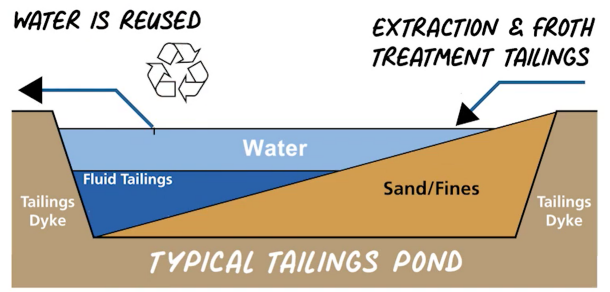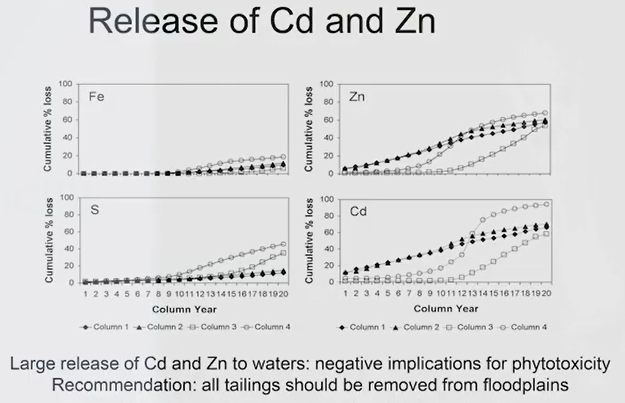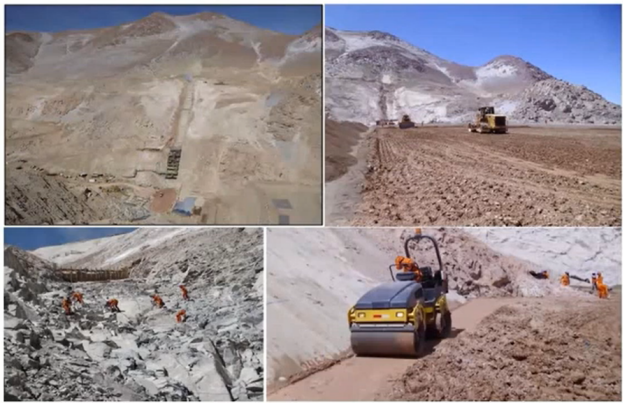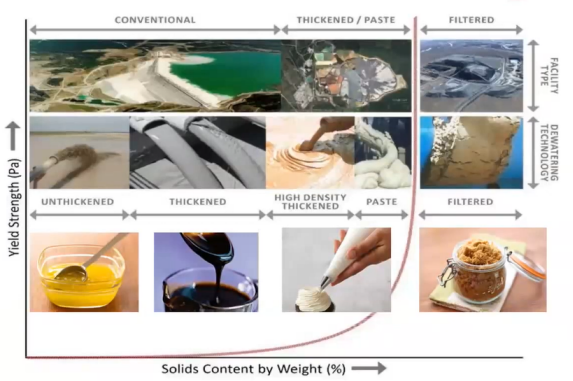Tailings and Tailings Storage Facilities
1-What are Tailings and Tailings Storage Facilities
After the desired mineral has been removed from the ore, trash is left behind, known as tailings. They are made up of crushed rock, water and traces of metals including copper, mercury, cadmium, zinc, and others. Tailings are often kept on the surface in structures known as tailings dams or tailings storage facilities after leaving the mine processing plant in a slurry state (diluted with water). Tailings storage facilities (TSF) are engineered buildings that include tailings dams and other works to keep the waste in place. They are made to hold tailings, which are the waste left over after valuable materials are taken out of metal ores, and to control any water that comes with them.
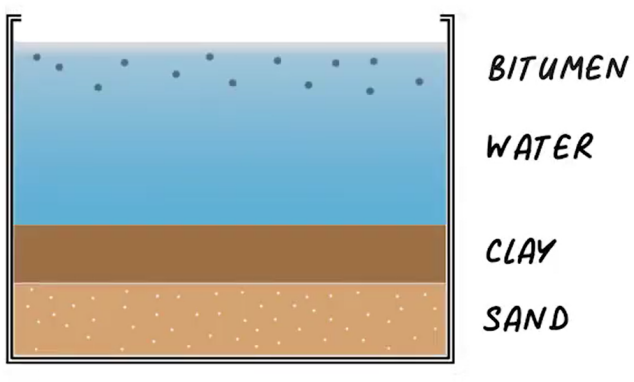
Mines be it copper, diamond, gold, oil sands or
Tailings Storage Facilities
any other all produced tailings that must be reclaimed. Oil Sands surface mining involves digging the oil sands out of the ground using large excavating equipment. As the hole is dug out, a dam is constructed to enclose the space to store the leftover materials.

This temporary storage space is called a tailings pond. Once the oil sands have been removed, they are sent to a preparation plant be crushed.
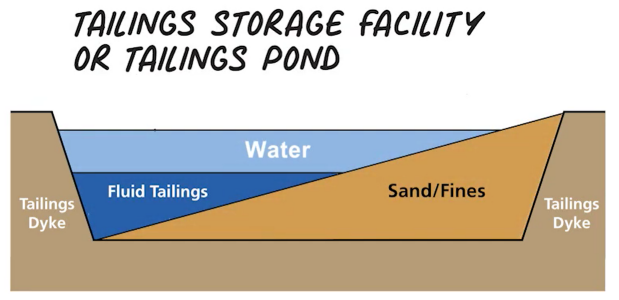
Hot water is added to the excavated material and the resulting mixture is pumped to an extraction plant. The extraction plant removes the oil and a froth slurry and produces tailings made up of coarse and fine materials, water, and some leftover bitumen.
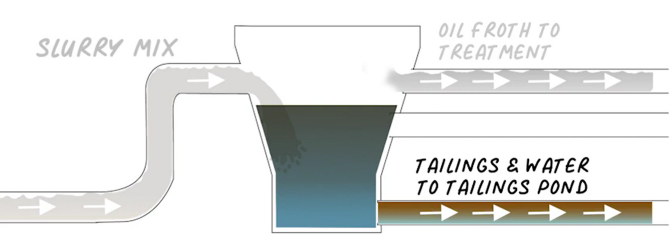
These materials are pumped to the tailings pond. The frost slurry that is recovered is typically made up of bitumen, water and solid particles. It continues through the production process and enters froth treatment. Here operators add a diluting or thinning agent to remove the remaining water and solids. This produces a thinner oil product that can be sent to an upgrader to produce synthetic crude oil.
The leftover water solids and trace amount of oil is pumped to a tailings pond. Most of the water in the tailings pond is recovered and reused in the extraction and froth treatment processes. Non recovered water solid particles and trace amounts of oil remain in the tailing’s ponds waiting for treatment. Tailings ponds are designed to protect surface and groundwater.
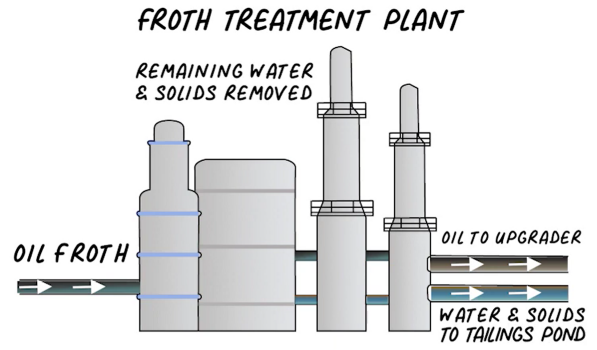
They are highly regulated. Our members from waterman engineers Australia also use modern technology to keep birds away from the ponds. industry continues to monitor the tailings ponds until they are no longer needed, and the areas are reclaimed. More than $10 billion has been spent by the industry so far on tailings management and the adoption of tailings treatment technologies.
2-Tailings Storage Facilities (TSF) – Challenges, Monitoring and Best Practice
Tailings storage facilities and tailings storage is one of the biggest decisions that needs to be made around a mining operation. I think there are many challenges facing tailings facilities globally. I think it depends on product; it depends on construction depends on location. But I believe that one of the main issues that waterman engineers Australia would like to concentrate on is data management monitoring, offering a unified environment for many stakeholders to access information that was previously dispersed throughout the mining operation and held within specific silos.
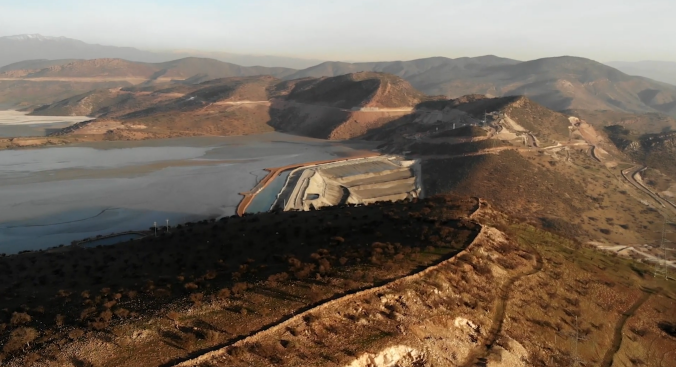
Therefore, it is crucial that waterman engineers Australia offer a consistent tool or site for users to access such information. The security, administration, reporting, digesting, visualisation, and integration of all these diverse major technologies that are supplying a Herculean amount of information to these activities, in my opinion, are the main problems.
I think another key challenge around tailings storage facilities is obviously the component of safety. These dams do fail. And while the percentages are lower, the impacts are really high, involve loss of life and it’s been about a year since the last major Brazil disaster. I believe that technologies like waterman engineers Australia can be used to facilitate a specific safety emphasis, complete tasks remotely to the greatest extent possible, and reduce the amount of time and miles required for the organisation.
So that we are looking at structures and embankments remotely, we are deriving information remotely, we are processing it, and where appropriate, we are putting eyes on the ground to go and have a look. That safety aspect, in my opinion, is quite important. The Swedish Council of Ethics of IP Funds and the Church of England Pensions Board formed and served as chairs of the investor mining and tailing safety project.
In response to the call for a new global TSF management standard, a group of investors representing more than $1.3 trillion in assets under management decided to act as an independent watchdog and asked 727 extractive mining companies to disclose information about their TSF facilities in the form of an online disclosure database, which is essentially an investor register.

The United Nations Environmental Programme (UNEP) and the International Council of Mining and Metals (ICMM) have announced that they are assessing a recently released draught standard on the principles for responsible investment. The fact that every single ICMM company supplied information is highly intriguing, and I believe that this is a very significant statistic. The first publicly accessible global database on tailings dams was published on the one-year anniversary of the Broomall Dino tailings dam failure, which claimed 250 lives.
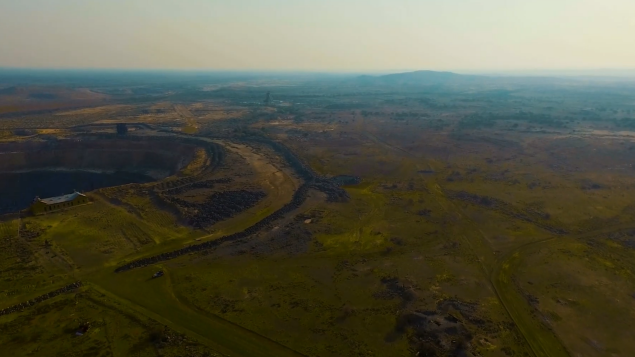
By allowing public regulators, institutional investors, researchers, and local people to examine precise information on more than 1700 dams, this database has now brought the mining industry to a new level of openness. This is divided into categories based on a wide range of variables, including location, company, dam height, heart rate, volume, and risk.
I believe it is a fantastic integration of data that can set us off on a path to truly understanding tailings facilities and involves a significant amount of ongoing research. And that is preparing to be started very, very soon.
So, this presented mining companies with a large challenge, one company that we’ve spoken to has estimated that it took about six weeks for one person to pull this information together, look at the format of the information verified, and get it into a format that can be disclosed and reported. So, multiply that out by the number of facilities that companies could be operating. And you get a very large number.
So, this has meant that mining companies need to concentrate on where the data comes from. Is that correct? Who needs to approve it for release? And is that data 100% accurate, that takes a lot of effort and a lot of concentration and is quite risky for those businesses. In order to mitigate that risk, we can start putting tools together that help collate that information and provide it in a format that can be easily ingested by things like the care disclosure database and data portal. we find that these operations whilst the data is stored and as an accurate, putting it together in relation to the 69 questions that were asked is often not done.
Thus, it was a matter of gathering that information and having it examined and verified by other individuals. Therefore, that was a major obstacle to overcome in this process. The operations of a corporation are not all centred in one place. They therefore conduct business globally. There are numerous time zones and numerous languages. Therefore, it is quite difficult to ask for, acquire, and review that information efficiently. Since English was the reporting language, it was occasionally necessary to convert the data back into that language. Therefore, just making sure it was done accurately, precisely, and appropriately reflected what are frequently fairly complex questions.
Preparation for the next round is obviously about looking at the data points that were collected last time making sure that information is up to date and accurate, easily available in the right format. Getting that in a consistent electronic format will make a massive difference. And then understanding when those dates are and getting the data back timelessly, and that involves making sure that the sign offs are done at the right time.
We see that using waterman engineers Australia can have a role in that you are easily able to see what was reported last time and update that information. You can version your information, so you can see what the report was last time in relation to what it is for this time of disclosure. Because the information is electronic, it is easily able to be transported to the Reporting portal in terms of preparation. I think something that will really help is operations thinking about how they want to report this so physically conceptualising what those reports would look like internally and externally compare apples with apples and get that information out quickly.
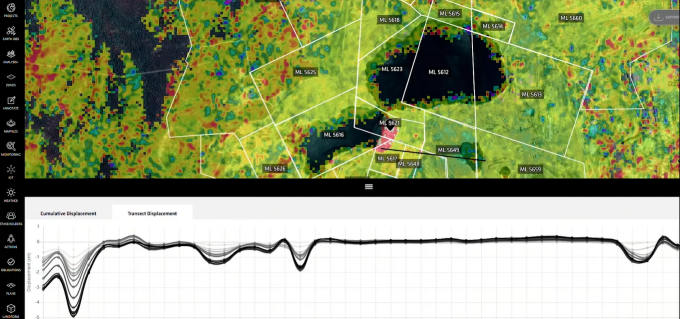
The spatial component within tailing storage facility monitoring and reporting can’t be underestimated. We’ve seen examples of assets that have owned tailings dams over time, they’ve reported those jointly, just having that information available on a map is a good step and understanding what you’re going to report when you’re going to report and how you’re going to report on it.
So, systems like waterman engineers Australia, are able to give us a macro view, which is a concept I like talking about macro view is really about satellite kind of level capture of information, where you’re getting big, chunky understanding of what’s happening on the ground then micro is the ability to then one in on those areas of concern with different technologies or different ways of acquiring information and really getting to understand those.
I think there’s a lot of exciting technologies out there, like glass terrors LiDAR product, which is on ground, smaller, cheaper devices that can be deployed quickly and give results back in near real time. The ability to put those into a system that manages information from end to end is critical waterman engineers Australia is doing quite a lot of work in the landforms side of things.
We’ve been doing a fair amount of work on waste rock dumps in Western Australia, particularly looking at things like gully erosion, and automatically calculating volumes out of that gully erosion after rainfall events. So, looking at what levels of precipitation can start causing an impact on those weights, rock dumps, how big those volumes are getting, and tracking who needs to go and fix them and mitigate those changes in size, we can get a lot of that work done remotely from one LiDAR mission. And then having people going out with tape measures and doing it that way. I think investment into algorithms such as tree cancer, vegetation, community identification, via drone, are critical technologies that are going to move us forward in the rehab and tailings monitoring space.
I think the macro and micro concept also exists in in the agronomist space, you can use NDVI to look at your fields and pastoral areas. Zone down into key areas, use Plant and Soil sampling to understand on the ground what’s happening, and then treat with the right fertiliser at the right rate at the right time. So, I think that macro and micros is not strictly just the mining thing, we can apply that, obviously to several different areas, including waste and waste sites. I think that’s exciting. And something that the waterman engineers Australia team is going to be looking at going forward.
3- The What, Where How and Why of Mine Tailings
The company is starting to clean up and again that the cost could be billions and billions of dollars, because these are very large systems. And hopefully they will compensate the town that’s a bit up in the air at the moment. So that’s the sort of very bad side about tailings and good side. But so why did why should we think about tailings? Why should we research tailings and tailings dam failures?
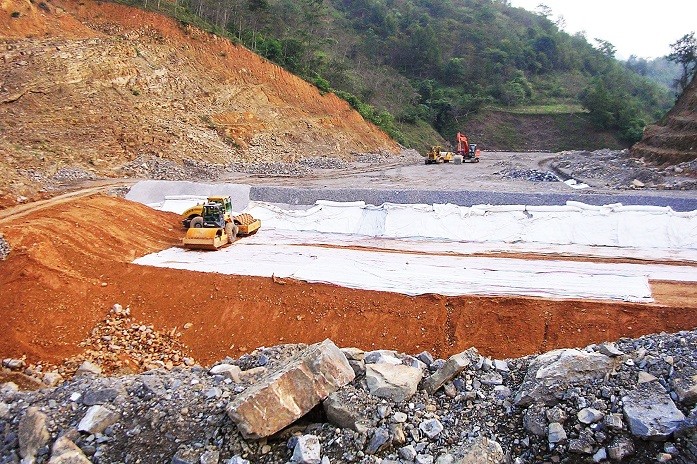
The first thing that we can contribute to is understanding. So, it’s a lot of words, understanding how these contaminants how these toxins might be released once tailings get into the environment because we’re geologists and geochemistry, we can do these studies, and that will help to design management schemes or remediation schemes, if we can understand are the contaminants going to move, or are they not going to move that really helps.
This is a real Pilcomayo that we studied for about 20 years. And this is a Cerro Rico hypocrisy. So, it’s a rather magnificent mountain at about 4500 metres above sea level in Bolivia. And it’s a mountain full of tin silver lead zinc veins, it’s very rich, or at least it was. So, before 1540, the indigenous peoples didn’t mind the mountain. They thought it was wholly sacred. They left it alone. When the Spanish came in 1540, they thought there’s lots of silver in that mountain fantastic.
Let’s get in there and mine it. So, they mined it like crazy. And they mind it’s like Swiss cheese now. And it was the basis for their empire from 1540 onwards. To get the silver out, they used a lot of mercury, which probably came from Slovenia at that time and even since to amalgamate the silver. And the waste here the veins are very interesting from the economic point of view. But the wastes are very toxic. There’s a lot of mercury in the wastes. There’s arsenic, antimony, thallium, almost every element under the sun.
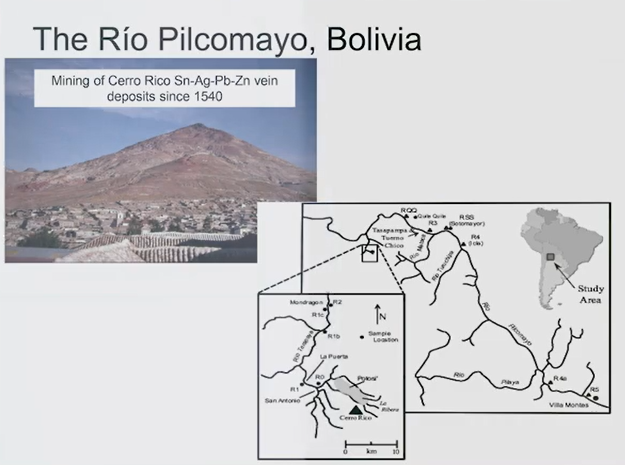
This is a town apostasy. It’s the mining town. Even when I went there in 1998. The miners there were still miners who were working small scale, and they would get up and walk up the mining shopping street. They would buy a candle for their helmet. They would buy coca leaves to chew for the altitude. And they would buy alcohol to give to the goddess of the mountains, so they didn’t get killed. It’s can go out here and you can actually go in mines tours. It’s fascinating to see how it works. But we’ve been studying the Pilcomayo. The Pilcomayo is a very large river starting at this area in the high Andes, and going downstream through Bolivia, into Paraguay and actually comes out at Argentina.
It’s a very long river system. And it like a lot of river systems around the world. It has gotten tailings a lot. They’ve constructed tailings dams in the last 10 years, but before there was nothing, so all of the tailings were discharged to the river, all of them. We’ve been able to find evidence that it goes at least down here to Villa Montez, which is about 500 kilometres downstream. So, the whole of the Pilcomayo has mine tailings in it.
This is what it looks like It’s a fantastic River. It’s a beautiful area but it’s rather odd. Because this is a dry season in 1998. You can see that the river is grey. That’s a bit odd. Grey rivers are uncommon. And the reason it’s grey is the only thing that’s in it is mine tailings at that time.
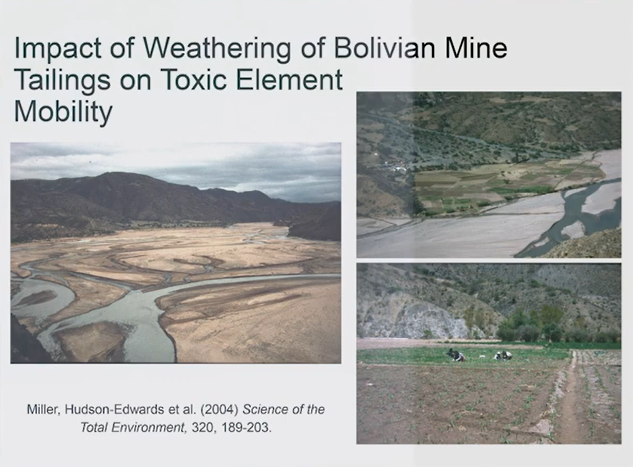
In the wet season, it’s a normal river. It’s full of grave tailings in the floodplain is pink, which again is rather odd. But that’s because these tailings will then oxidise in the floodplain. We know there’s a lot of material in this river. We don’t know how deep that is. But it could be quite deep. So Big Endian River system. So, we’ve done several studies, and one of the more recent ones we did was to look at indigenous villages. These are villages along the Pilcomayo. And you can see they have agricultural areas; they grow crops for themselves. And for some of the larger areas. Here they are growing some crops.
We were interested to see is there any impact of the tailings and on the crops that they grow. So, they luckily don’t irrigate the fields with any water here, they know that water is very bad, they get it from the mountains. But occasionally the tailings will get deposited on this field. They are contaminated. We did a study to on some of the crops and fortunately, they were mostly fine. The only thing that had high things like cadmium were lettuce. Anything leafy that they wouldn’t wash had some contaminants, but most things were fine. That’s great news.
How did the tailings react if they were on their own, with soil, or in a simulated tailings dam failure, where you have a layer on top? How did they weather? How were these elements released, would that have impacts on some of the poor, these poor waters, and vegetables.
So, David made his columns you can see there, he filled him with these materials. And then he conducted experiments where for three weeks, he would rain put water on the columns, that was the wet season, for three weeks, he would drive them dry them out. And that was the dry season, he collected the water at the bottom. And then he studied the geochemistry of the water, and the geochemistry of the tailings before and after the experiments.
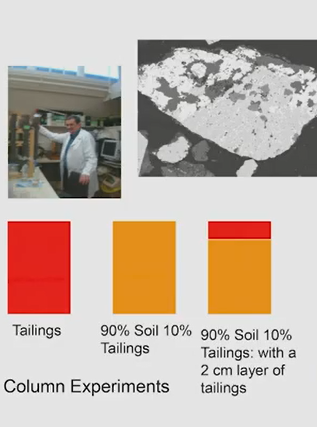
I won’t go into too much detail, but just to say these are so he did it for 20 of the years over three years. It’s a long time to do experiments. But he got some very nice data. I’ll just show you a little bit about zinc and cadmium. Now, if you remember your periodic table, zinc and cadmium are in the same column of the periodic table. And they normally behave in a similar way. They have the same atomic radius, some excise and they both form to plus Catalans.
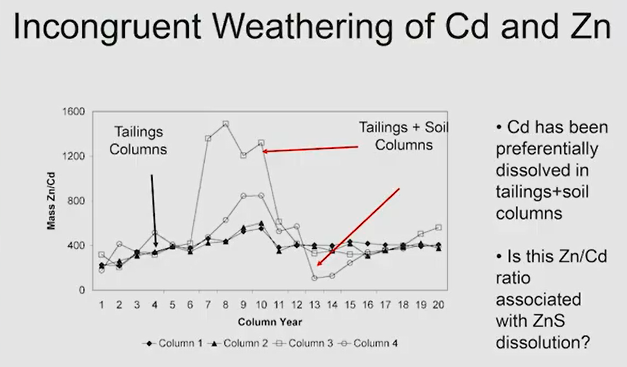
So normally they we see similar behaviour, but you can see from this, if that’s true, then the line should have been flat. But you can see it’s kind of not all over the place. And cadmium is much more toxic than things. We were quite interested in this behaviour why was this happening? He went to the minerals, and he found one of the reasons was this mineral.
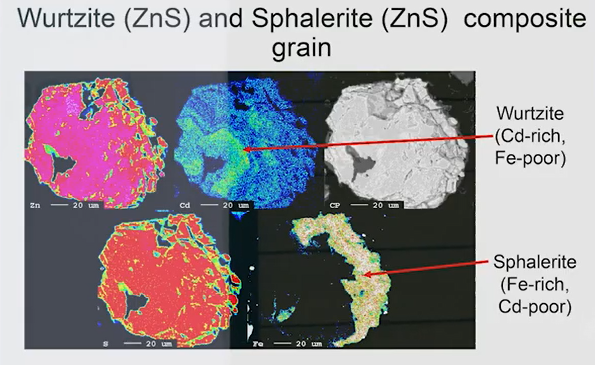
This is a zinc, the zinc sulphide minerals. These are a microscope we use that cannot be chemicals in us in minerals. This is all zinc. And this is all Sulphur. It’s zinc sulphur grain. You can see the cadmium here is more concentrated, the lighter colour is cadmium.
There’s lots of cadmium here and no cadmium here, and no iron here and lots of iron here. What he found is there two forms two minerals of zinc and sulphur, there’s one called warts light that contains the cadmium and there’s one can smell right, and that contains zinc. work site is much more unstable than sphalerite. So, it will dissolve first. And that’s why we see cadmium coming out in the pore waters before zinc. The cadmium is coming out of the word site. So that was one piece of the puzzle. And the next slide shows you how difficult it can be to work on natural samples. So don’t it’s quite complicated. But what this is showing you plot, and this is sort of a summary of all of the processes going on all at the same time that explain these ratios.
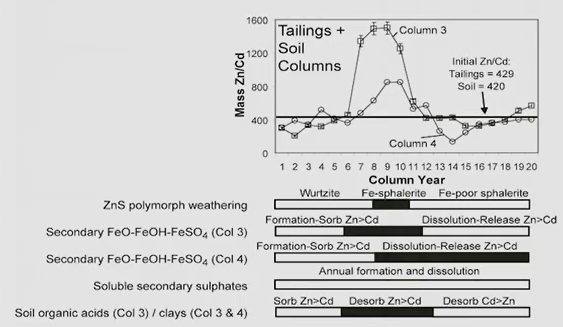
The zinc sulphide the word site, whether it’s first and then the spell, right. But at the same time, we have secondary minerals, iron, rust iron, rust iron forming, sometimes they take up zinc and sometimes they release it. We’ve also got other sulphate minerals that form during the dry season and then dissolve in the wet season. And then of course we mustn’t forget in the soils we’ve got organic matter and that plays a role as well.
I think we have the tools to do that. And then the main message is that over the 20 years, a lot of the cadmium was leached out. So, in these, this one particular 100% of the cadmium was leached. Now lab experience is much faster than the natural world. So that’s probably an overestimate. But it just shows that the cadmium is very mobile. And we’ve tried to talk to the people to grow crops, that we’re not taking up cadmium, in this particular case.
4- Tailings and Tailings Management Current state, Challenges, and the Future
Tailing it’s the waste generated in the process. If you mine 100%, or we’re talking about 99 point, something that is the waste after it’s processed, and that is the tailing. Everybody’s looking for solutions that’s fine. I think they are treating solution as island for example, the watering islands. But then we are talking a lot about reprocessing connected to that. We also have water treatment. There are other questions like how do we stack the material, the storage of the material? Is that safe? Is that stable or whatever questions? I think there’s still a lack of knowledge in many of the areas and it’s about building the competence and capability and of course the knowledge.
1. Challenges for the mining industry in tailing
To make it simple to point out a few things, I think the lower head grade that is causing the problem, water scarcity, of course then we have the difficulty to do water so material due to its complexity. And this is very much due to find but in the last year’s let’s say a couple of years ago the sustainability of that is very important for most mining companies etc.
2. Tailing Management worldwide
When we have looked into how it looked like geographically and of course there are a number of countries or markets that are far ahead compared to others and it very much depending on what are the drivers right now we have mentioned sustainability and all that but water scarcity, legislation, regulation, etc. So, we can see that some countries we can mention like Brazil, or this but Sheila a rule we have North America, US and Canada, Australia we could probably also add China and South Africa
I think it’s really important now that the mining companies or the industry there are showing their way forward, they need to take a decision what is the right way of moving forward.
This industry and all the fascinating challenges that these projects present very fast paced, unique, highly variable projects. I’d like to just kind of present a broad overview of that today and give a little bit of perspective on kind of how these projects take place from start all the way to finish. As far as the mining process goes, it all starts with the ore.
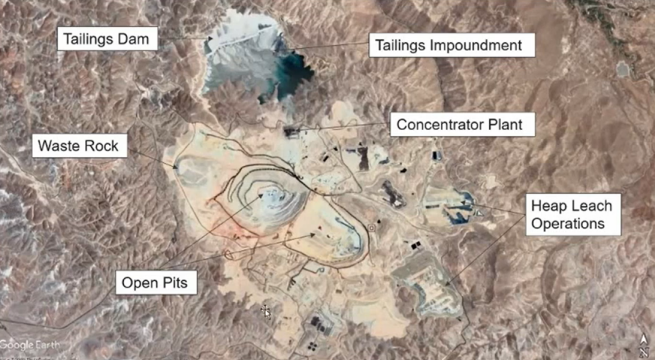
Ore is essentially just rock that contains a valuable mineral like copper, gold, and so forth. So, it starts by blasting the ore out of the ground. After the order is extracted, it can be processed in a few different ways. The first way is heap Leach and in heap leach, ore is crushed, and it’s placed in large piles. It’s essentially leached with a chemical solution that extracts the target mineral from the ore that leach shade is then collected and the mineral is extracted from the leach aid solution from there.
The other option for processing is concentration. Those entails transporting the ore to a concentrator plant, the ore is crushed and ground up into soil sized particles, so nothing larger than sand, and all the way down to silt and clay sized particles. Then a tremendous volume of water is added to the ore along with chemicals to extract the mineral from the ore.
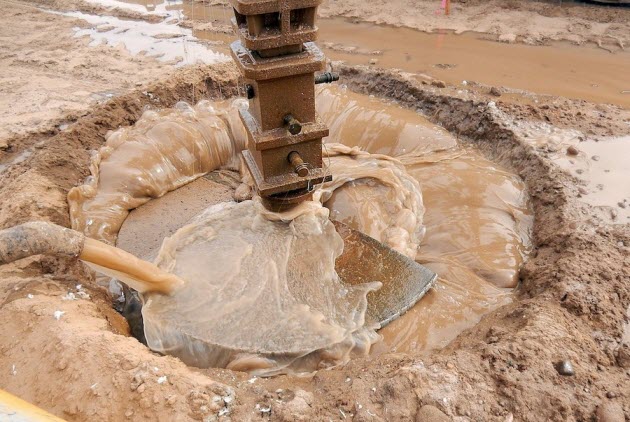
After the mineral is extracted from the ore, what’s left over is a large mass of soil mixed with water as a slurry. And that is the material that we call tailings. You can think about just the sheer volume of tailings that’s produced on a mine. This site, this is one of the facilities that is a copper mine and copper is typically found at an ore grade less than 1%.
For every metric tonne of ore that’s being produced less than 10 grammes of that turns into copper. You’ve got 99% of that material or more turning into tailings which is a waste material. Because it’s produced as a slurry, it’s deposited in an impoundment or reservoir, and it’s retained by a dam.
Mines are operational for years, decades, a lot of the time. Tailings are continuously deposited into the impoundment and the dam must be raised to keep up with the continuous deposition of those tailings. You can see the tailings sort of create a beach within the impoundment and then there typically will develop a pond as well. More details about sort of the different components of these tailings’ storage facilities as well.
5-Tailing Detail for Engineers
kind of already walked through this but just to give a little more, step by step process, the materials pulled out of the ground, it’s crushed down to say gravel sized particles, it’s then ground. This is called a ball mill. These little steel balls are placed inside this drum. The ore is placed in there and it’s rotated to essentially pulverise the particles down to soil size material.
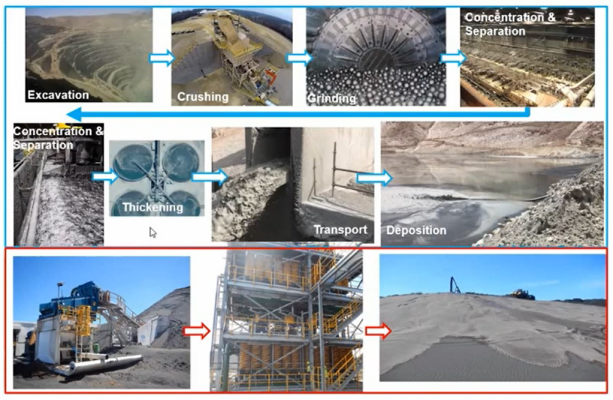
It’s sent to the concentrator where it’s combined with water and those chemical agents, and our valuable mineral is separated out and we’re left with our large, massive tailings. One option is that the tailings can be thickened, meaning that some of the water is removed from the tailings and reused at the concentrator. This is a way of saving water and reducing water losses within the tailings impoundment and water is going to be a pretty big topic in this article.
So that’s just the start of it. After thickening, if necessary, the tailings are transported. You can see that the tailings are behave like a liquid. It’s a material that it flows easily. But it is transported as a slurry. This is a material it’s probably 50% solids content or so. After it’s transported, it’s then deposited into the impoundment and essentially just flows away from the embankment or the dam into the tailing’s reservoir.
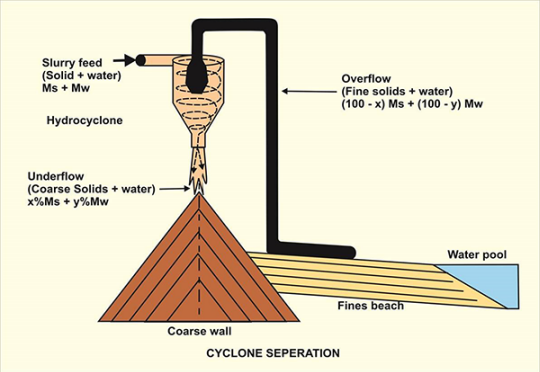
As you could imagine, the solid particles will settle out as the tailing stream loses energy and the water will continue to flow and eventually pond up. Now I mentioned earlier that these dams continue to be constructed over time, as more tailings are deposited within the impoundment. The dams can be raised by a variety of materials. And in some cases, the dam is actually built out of the coarse grain portion of the tailing stream.
This is one of those cases. In that case, the tailings are sent to what’s called the cyclone station. It’s sent to the Cyclones where it’s basically spun around or centrifuge. The smaller particles stay in suspension as the material spins, and the heavier coarser particles drop out at the bottom and that material becomes your embankment construction material. It’s deposited on the embankment as a slurry, just as it would be in the impoundment, the solid particles are going to settle out, and that water will eventually seep into the embankment.
You see this dozer here, dozers will then push the material out into a constant lift height, material will be compacted, and the dam will just continue to be raised that way, basically, for years on end.
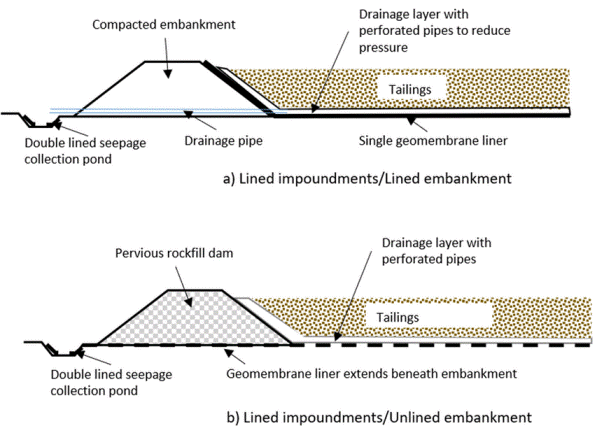
A little bit of an intro to the kind of mining and tailings process. And that is sort of becoming clear of what is a tailings storage facility?
It is a facility that is meant to store and manage a combination of finely crushed rock and water as a waste product from the mining process. Mines are operational for at the very least years, if not decades, on this particular facility opened in 2006 and will continue to operate for another about 10 years. These are projects that last many decades at a time. Then certainly present challenges in continuity of management and continuity of practice.
Water is a huge component of all of this water is used at the concentrator and water is used to help transport the tailings because it’s pumped as a slurry. So, managing the water is critical in an environment, this site in in the desert. Water is scarce and so it’s really important to minimise losses in terms of evaporation seepage into the dam Foundation, and various other components.
1. What are the Key Issues?
Now we’ve defined what the facility is, what goes wrong? What challenges do these facilities present? I think this first bullet point here kind of says it all. It’s really the big piece of all of it is that safety of people and the environment is of the utmost importance on these are facilities that carry with them a tremendous amount of risk, and tremendous consequences if they’re not managed safely and responsibly.
This is a tailings dam failure from about three years ago, in Brazil, the dam instantaneously collapses. This is an instance of static liquefaction. It sends about several million tonnes of saturated material downslope. There was a village downstream of this facility, and over 250 people were killed in this event. This is really kind of the meaningful portion of what for a living is that this is an industry that has not been managed safely throughout the years.

In our world, where metals are our only growing and demand, mining isn’t going anywhere. It’s really of the utmost importance that we try to make these facilities safer and do everything we can to improve our understanding improve our management of these facilities. It’s something that’s quite meaningful to be a part of that industry that’s moving in a direction of improving the safety improving the environmental sustainability of these facilities in the mining industry as a whole.
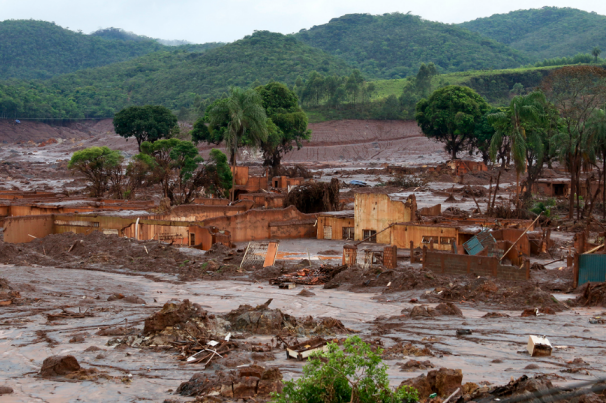
Second bullet point kind of ties into what I just mentioned, as far as the mining industry. The mining industry has not always behaved safely and responsibly. It is really of the utmost importance to mining companies to do everything they can to re-establish public trust and ensure that this is an industry that can last for a really long time. Some of these issues that can occur with these facilities.
Of course, long term physical stability. As geotechnical engineers, this is really Its kind of one of our bread-and-butter items is slope stability. We managing water appropriately? are we developing saturation within our facility? Is there liquefaction potential, so on and so forth. There’s obviously a chemical element as well in mining with all the use of chemicals and to extract the minerals and the natural chemicals that occur within these ore deposits.
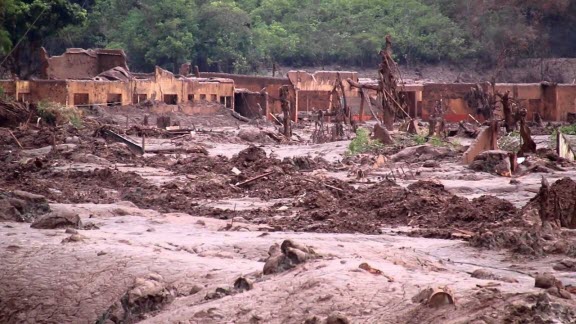
A lot of that goes into water management, whether it’s surface water, groundwater, understanding and characterising those components of your site. Just two more items that I felt were relevant is that, since these are facilities that lasts for decades at a time, you can often get a situation where a manager or an engineer of record of one of these sites can leave unexpectedly, and with that person leaves a tremendous wealth of knowledge, a lot of protocols a lot of ideas.
If those aren’t passed along correctly, that’s when failures like this occur, because items haven’t been carried on through the years that are paramount to the safety of these facilities. This last piece, this is something that I think pops up in any construction project in any sort of design is that you can never be comfortable with deviating from design and an elevated level of risk.
These are facilities where anytime that you see something that doesn’t quite look right, it needs to be raised. Because then if it happens, people start to get used to it and it sort of snowballs into just being used to deviance from normal operating conditions. So, sort of established all the things that can go wrong with these facilities.
A-Consideration for Design
1. Site Characterization
What do we do to make sure that we’re creating a safe, sustainable, responsible design? It starts with site characterization. Starts with your climate. Is it a wet climate where we have too much water? We’re going to have to figure out where to store water, where to discharge water etc? Is it a dry climate, discussed with our sites where we’re going to have a deficit of water, and we’re going to need to draw from local water sources and really minimise their losses.
Is it a cold climate where we must worry about freeze thaw effects, these are all things that you’re going to have to take into account in these in these dam designs, understanding the local geology, local groundwater, local seismicity, are all huge components of these designs.
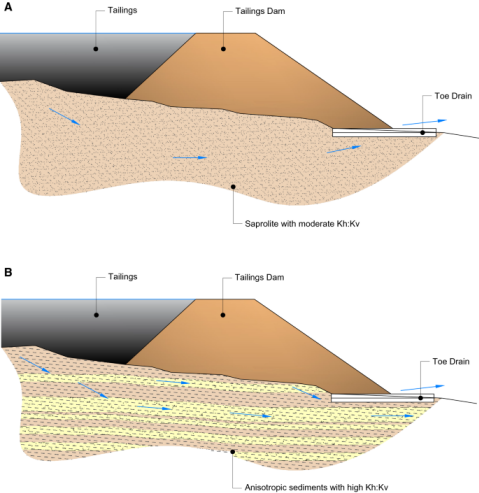
2. Consequence Classification
The consequence classification, this is essentially what are the downstream impacts? Are there going to be fatalities if this facility collapses, are we going to take out roads, power plants, water treatment plants, obviously, there’s an environmental component with any failure, where you have an unplanned release of tailings.
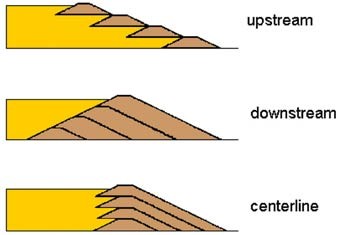
So, these are all things that that you’re going to want to understand as you create your project and develop the level of redundancy and sort of a factor of safety on a project.
3. Design Criteria and Basis
Any design starts with what’s called a design criteria and design basis. The design criteria are essentially the set of conditions that you must meet to be successful in your project. That could be regulatory, or just internally defined by the client or the mining company.

On these are things like design flood, design earthquake, and so forth. Design bases are more on the side of the objectives and what you aim to achieve with this facility. For example, what total mass of tailings do we want to store? How quickly are we going to produce these tailings? How much water do we have available?
On the second, the last bullet point is a really, big one. Expect the unexpected, that’s not entirely true, because it’s silly to think that you’d be able to identify what issues are going to occur. But the idea is to make your design flexible so that it can handle potential changes down the road, whatever is going to come up and that could be or tailings material property changes, so maybe there’s an increase in plasticity, and now the tailings retain more water than they typically would before.
Now you have a shortage of water. Is your design resilient to be able to handle things like that? Can you handle a change infrastructure in production rate, and an increase in construction schedule? Are you ready for severe weather and climate change? Can we handle it change in or reserves say the mind company approaches you and says, we have 100 million more tonnes of tailings we need to store can this facility manage it? Or could we think about raising the facility and raising the dam and so these are all things that you have to keep in mind as you work through the early stages of these projects is making sure that the projects are flexible enough to handle all the curveballs that are certain to come your way.
4. Plan for the full life cycle from the beginning
This last element is huge, and this is something that hasn’t always been the case in this industry is planning for the full lifecycle from the very beginning of the project.

That means that mining companies must be able to prove that they’re capable of closing a facility before they open it. This is something that has is kind of rearing its ugly head. Now as many mining companies in the 1800s, 1900s. They mined what they needed to mine, and then they walked away and left it and that’s why we have Superfund sites and reclamation sites across the world that are polluting and causing slope stability and their safety concerns, with no one held accountable.
We’re kind of trying to catch up to close these and make them safer. Obviously, the industry is moving in a direction of including that in the design from the very beginning.
B-Typical Design Stages
Speaking of the very beginning, how is it that these projects go from an idea that a mining company must actually being constructed in the real world? The answer is that this process can take 10 years, maybe 15 years, maybe more to get from the conception of the idea, all the way down to it being executed.
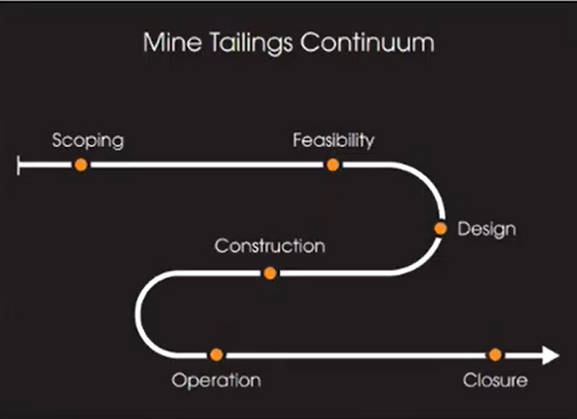
1. Conceptual- Look at a bunch of different options
That’s because you really want to make sure you’re leaving no stone unturned, so to speak. You’re really evaluating every possible avenue, and you’re getting input from experts, you’re going through several design phases, and reviews, you would start with a conceptual design phase, where you might take 12, 15 different alternatives. These are different sites you might look at and develop kind of a basic level design for each of the sites. That the idea in this phase is simply to simply weed out what you know, is not going to work and maybe narrow it down to three to five options.
2. Prefeasibility – Narrowed down to a few viable options
You would carry those forward into the prefeasibility phase, where you would then start to advance your knowledge base and advance the design and cost estimates and begin to bring in some more advanced estimates, or assumptions and estimates.
You might perform what’s called a trade off study in this phase and compare that kind of few finalists’ sights from the conceptual phase. The goal of the prefeasibility phase would be to ultimately select your final design or the final design option and carry that forward into what’s called the feasibility stage.
3. Feasibility – Moving forward with a selected option from prefeasibility
Again, with this phase, you would just advance the design began doing your analyses all of your calculations, the design advancing the field investigations. This is the phase that’s suitable for environmental permitting.
So, there’s going to be some very large assumptions and decisions that are going to be made as part of the feasibility stage. Water Use requirements, footprints, ultimate elevations, things of that nature that, from that point forward, you’re going to be kind of locked into what the permit says. You move on then to the basic engineering, again, just advancing the design and then finally, detailed design.
4. Basic Engineering and Detailed Design
This tells the mining company tells the contractor or the construction company how this thing’s going to be built from that design, or that sort of nebulous idea back in the conceptual design phase. Now we’ve taken it all the way through, and it’s time to build it, we’re gonna prepare the foundation, we’re going to grout, we’re going to compact material, we’re going to start depositing tailings and this is how it’s all going to come together.
C-Tailing Disposal Technologies
There are a few kinds of key elements that go into the design of these facilities, sort of key decisions that have to be made along the way. One of them has to do with which tailings disposal technology is selected. The tailings are produced as a slurry and conventional tailings and projects that worked on might be 25%, solids content biomass, so essentially, it’s just a liquid with some suspended solids in it.
1. Water management is key
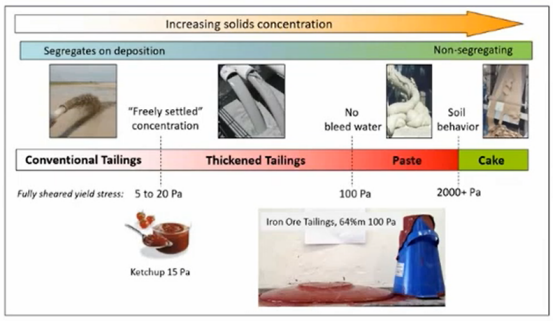
You can essentially remove as much water as you want with an increasing level of cost that decision is really going to come down to how far you must transport the material, what type of material it is how the soil material behaves, what your production rate is, and cost is a huge one.
You might thick in the tailings which means removing some of the water down to say 50%, solids content, paste, you might be more in the 70%, solids content range and then cake where the material is actually all the waters kind of squeezed out and you end up with really Soil behaving material at optimum water content.
The paste and cake technologies are sort of increasingly expensive from the more conventional and tailings type, deposition methods those tend to be used in smaller scale projects. At this stage of the technology, those options really aren’t implemented at large scales. But the industry is moving more and more in these different directions as more technologies are developed. Just to kind of give a little reference, when you’re in this conventional sort of thick and tailings range is materials going to be in a sort of ketchup or yoghurt, type consistency, and then of course, increasing in shear strength and solids content.
2. Dam Types
The impoundment the tailings facility must be retained by a dam, assuming you’re depositing the tailings as a slurry. There are several options on how you can raise these dams. They all start with what’s called a starter dam that is essentially sort of a traditional water retention type structure, it might be a zoned Earth fill or rockfill dam with a low permeability, central clay core. Then over the years, you’re going to raise the facility and you have a few options on how you might raise the facility.
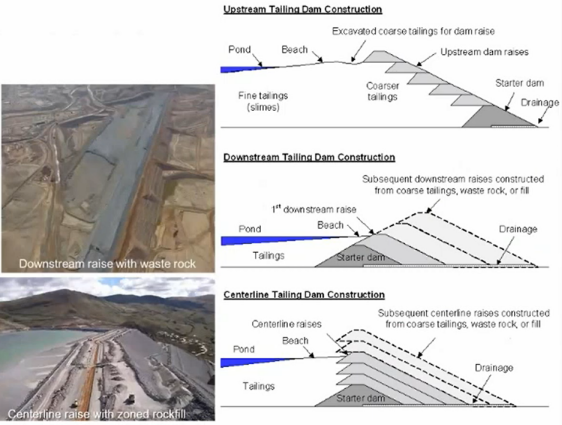
The first option is upstream raise that you see there at the top that involves placing your dam raise on top of tailings that have already been deposited. Now this is a very cheap method because you see really don’t have much filler material to use for each damn race. It’s also a method that carries with it a tremendous amount of risk because you’re placing each dam race on top of tailings material that may be saturated, it hasn’t been compacted.
It presents challenges that the other methods don’t. The industry is really sort of moving away from this technology. Because for that reason, this method has been associated with some of the failures that have occurred in recent years that’s not to say that this type of facility can’t be managed safely. But with sort of the increased scrutiny on mining and tailings in the world, most mining companies are sort of opting to spend a little more money and use a method that’s known to be generally a little safer.
Sort of the opposite half the upstream is the downstream and that involves moving up and away from the tailings pond with each raise. The difference with this one is that it is extraordinarily more expensive because you can imagine the volume of material increases sort of exponentially with each dam raise. You can kind of meet in the middle and do a site centreline race, which at the facilities and is one of them is our boat centreline raise facilities.
The dams can be raised using Earth fill some sort of soil fill material rock fill, or like mentioned the cyclone sand tailings material. There are just a couple of examples of those types of dams, you can see here a centre line arrays with zoned rockfill it remains the zones dam. So, you see this core travelling through the middle of the dam and then rockfill on the downstream and upstream shells of the facility.
Whereas the cyclone sand dam is essentially a homogeneous embankment above the starter dam constructed entirely out of this, the cyclone sand tailing material.
D-Water Management
It’s one of the biggest challenges that we face. Water can cause a lot of geotechnical issues with liquefaction and other things. But water is also a very important part of the whole process. There’s a lot of elements that go into managing water on these facilities.

1. Foundation Treatment
The first is foundation treatment. So, before the thing gets built, you want to make sure you have a good contact between your dam and your foundation. You want to make sure you’re mitigating any sort of seepage. Part of that is characterising the foundation beneath the dam.
Part of that is characterising your local groundwater conditions. You might grout beneath the dam to provide a seepage barrier beneath the dam you might excavate a cut off trench beneath the dam to get down to some more competent bedrock material. But it’s important to avoid sort of preferential seepage paths through the foundation and beneath the dam.
2. Use of granular filters
Another big element is the use of granular filters. Without filters, you run the risk of particle migration, whether it’s your underflow sand or the core of your starter dam or any other material really and filters just help to retain those materials and prevent a piping failure.
3. Use of Geosynthetics
Geosynthetics can also be used embedment under drains and seepage mitigation and collection is a big part of it. You want to be able to collect all the seepage that goes through the dam and be able to reuse that water. So, this is an example of a seepage collection system where the dam would be up valley here, the seepage comes from the impoundment runs through the embankment and is collected here. Ultimately, it’s pumped back to the concentrator plant for reuse.
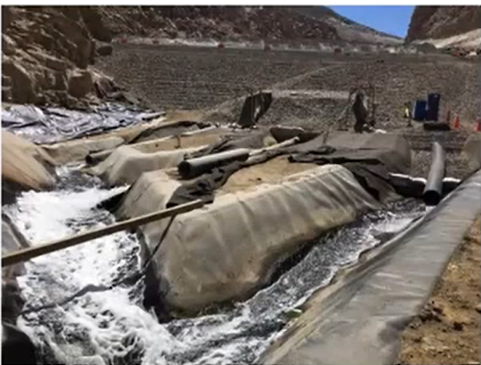
Just a couple more items wanted to touch on instrumentation is a big part of it, installing piezometers within your dam and within your foundation to monitor your pore pressure conditions and make sure you’re not getting elevated pore water pressures, you’re not getting rises in your phreatic surface that could potentially cause dam safety issues down the road.
E-Analysis and Design
There’s a lot of analysis and design as I mentioned earlier, at the very beginning with my sort of day-to-day responsibilities. There’s a lot of analysis and design that goes into these facilities.
1. Material Characterization
The first is material characterization. It’s important to understand what the properties of your tailings material are, what are the particle size gradations are we going to have enough coarse fraction to raise the dam out of Cyclone sand are we going to have to use a borrow source to raise the dam characterising your foundation and that site investigations that’s permeability tests, strength tests on all of the materials to feed into the remaining analyses and understand what the characteristics of the material are, that you’re working with.
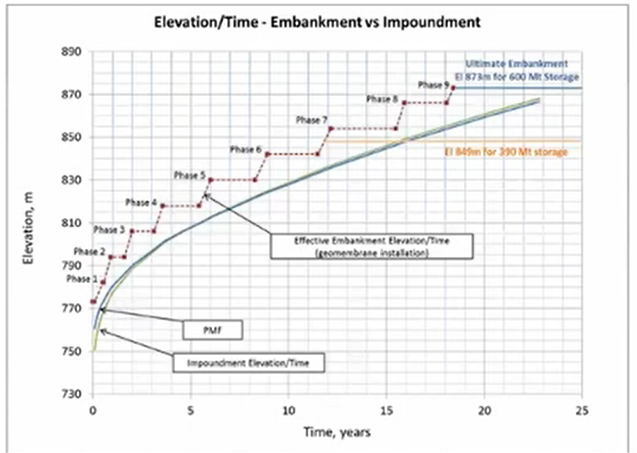
2. Material Balance
One of the key elements of tailings storage facility design is a material balance and that’s where you essentially consider the geometry of the valley that you’re depositing the tailings in. You understand how you start to predict how quickly the facility is going to be raised and from there, you can sort of plan your construction schedule, and the raises of the dam. This is an example the green line is your impoundment elevation with time and then this red dotted line would indicate, here’s how quickly we need to raise the dam in order to have sufficient flood capacity within the impoundment.

3. Water Balance
Water balance is also extremely important, predicting different flows on site and in understanding what your losses are going to be in the way of evaporation seepage into the foundation of the impoundment different losses of the concentrator and making sure that you don’t end up with a water shortage down the line that you didn’t predict before.
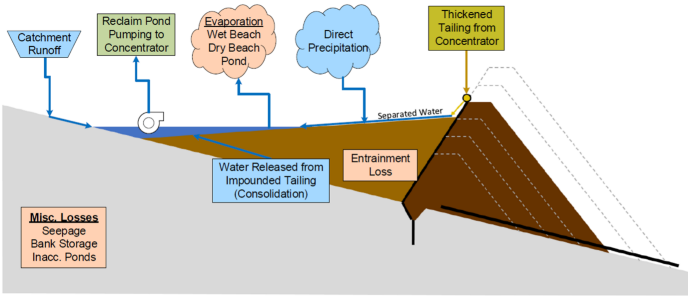
It’s important to characterise the nature of the of the site, of course, and that’s a huge piece of deformation and in a lot of these seepage are all these stability and deformation calculations that we do.
4. Seepage, stability, and deformation
Seepage, stability, deformation, those are big calculations that we do just to characterise, the phreatic condition, the slope stability factor of safety, static and seismic deformation of the embankment.
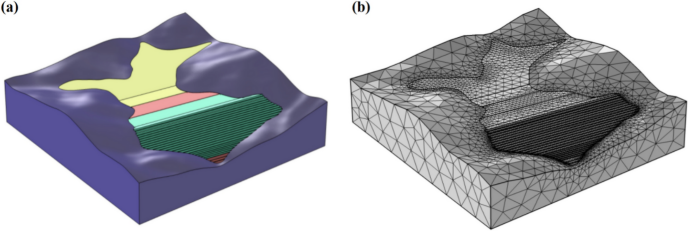
5. Characterise Geochemistry
We also characterise geochemistry as it relates to the groundwater and surface water and reactions that might take place over time, as well as well just mentioned, groundwater and surface water being hydrogeology and hydrology, characterising those aspects of the site and understanding what our groundwater flows look like, what our surface water flows, and during a precipitation event would look like how are we going to have to collect water, mitigate seepage, and all of these things. So, once we create this big, beautiful design and our detailed design phase, it goes to construction.
6- Decentralised solutions Tailings water treatment in the mining industry
We had to deal with mining wastewater, it was a big mining company in Australia who needed to treat is tailings water before two discharged this water into the natural environment. So, the quality requirements for this outlet water were very strict. The year was very high concentration of suspended solids, heavy metals, a lot of minerals and salts in the inland water. So, we needed to supply a very efficient treatment line.
This was one of our toughest challenges. This mining company had the site was 4000 metres above the sea level, it was a five-year project. So, we need to supply a solution that after the five years they would have to take to another place once the operation was done at that site, they will take the operation to another one and they would use the same water treatment plant very tough conditions, temperature during dropped down to minus 20 degrees Celsius.
So, we had to include every step of the treatment line inside a container with thermal insulation and heating system to maintain control temperature steady at 18 degrees Celsius with enough space inside to perform all the maintenance tasks of the water treatment plant. This project was a serial liquid discharge type, so we needed to supply a water treatment plant that was capable to concentrate over 80,000 milligrams of litre salts with minimal reject flow because the reject was going to be crystallised with an evaporator.
The costs of treating one cubic metre at evaporating system is around 600, $700,000. So, we needed to be very efficient in order to minimise these reject flow for the evaporator system. The most critical parameters in this case were
- Conductivity,
- The high suspended solids and
- The heavy metals present in this tiny water.
So, for the Waterman Australia water parameters, we needed to comply with local regulation which is very strict. So, our design or treatment line was consisted in first a decanter with oxidation in order to precipitate all the metals present in the water. Then, self cleaning this filter and 100 microns also with our air assisted backwash, because the TSS levels were very high and variable.
The air resistance system was the perfect solution to deal with the suspended solids. This technology offers guarantee protection for the UF membrane. After this, the UF membrane was placed to reduce the RO inlet. So, we can have a lower CIP cleaning frequency of the reverse osmosis membrane. The UF would retain all the colloid solids that could have caused the soiling of the of the reverse osmosis membrane.
Finally, the RO design will start with a double step of reverse osmosis. With an additional independent system that works as a third step to achieve 91% of recovery this is very high to achieve. 91% recovery with very difficult water, industrial mining wastewater. So, we have inlet water flow of 35 cubic metre per hour and the permit water flow was 31 cubic metres per hour, these 31 cubic metre per hour was discharged into the river almost with drinking water quality and the highly concentrated four cubic metre per hour were taken to the evaporator.
Thanks to this containerized solution, and with Waterman Australia engineering expertise, we were able to achieve the required water quality by the local authorities. So, it was a very successful project.
7- Dry Tails Stacking Solutions
Tailings operation should be about asset management, not liability management. Waterman Australia stack tailings technology gives our clients greater control to manage water assets. Significant financial savings are realised by recouping operational costs through effective wastewater recycling back into the mining operation.
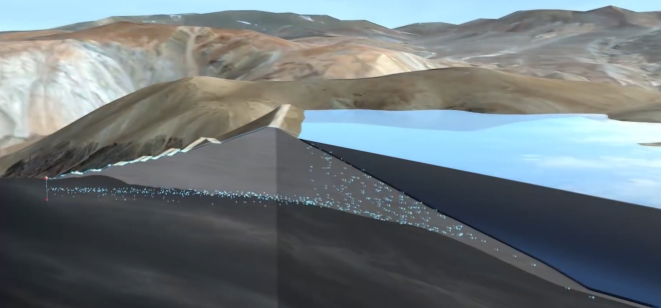
Wet tailings dams have no ongoing maintenance costs, which relieves future generations of that load. More than 200,000 tonnes of water are needed each day for a typical mining operation employing a concentrator with a 100,000 TPD capacity. About half of that water is wasted due to pond evaporation, thickening technology currently in use, and other factors. Compare that to the latest large capacity filter press technology from Waterman Australia, which can save about 50,000 tonnes of water per day at a cost of $2.50 per tonne. This results in annual savings of $45 million.
1. Dewatering Process
Waterman Australia dry tails process starts when the waste material would usually be pumped out to a tailings pond. The wet slurry enters a filter press where the moisture content of the material is reduced.
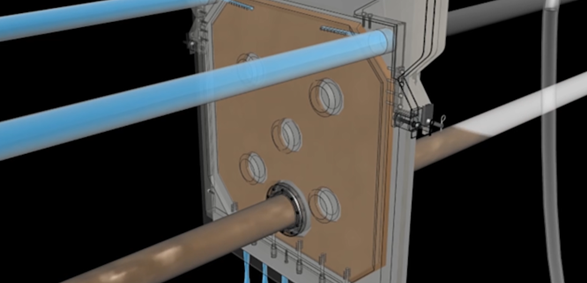
The feed slurry pump delivers the material to the filter press chambers via a lower centre feed. The force generated by the feed pump results in solids formation on the surface of the filter media with the liquid filtrate passing through the cake and the filter media.
Water exits the filter chamber through reporting in the filter plates. The lower feed promotes turbulence and mixing in the chamber allowing for homogenous filter cake production. Once the filter cake gets formed, bay doors under the Filter plates open up as the filter plates move apart. The filter kick falls on to Waterman Australia hybrid apron belt theatre where it is fed to the conveyer system.
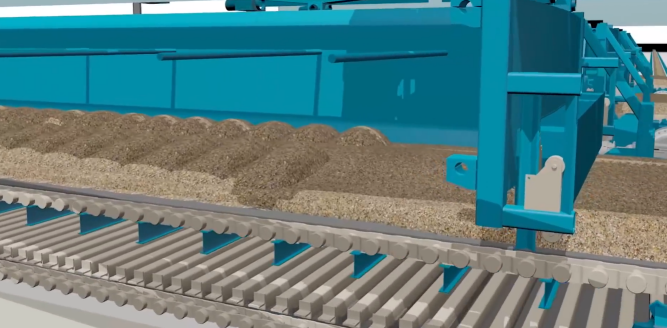
This dewatering process may take five to 30 minutes depending on material characteristics, such as
- Density,
- Porosity, and
- Other factors.
The arrangement and number of filter presses will determine tonnage of material that is processed per hour. The water that is collected in this process can be treated and returned to use in mining operations minimising the amount of makeup water required.
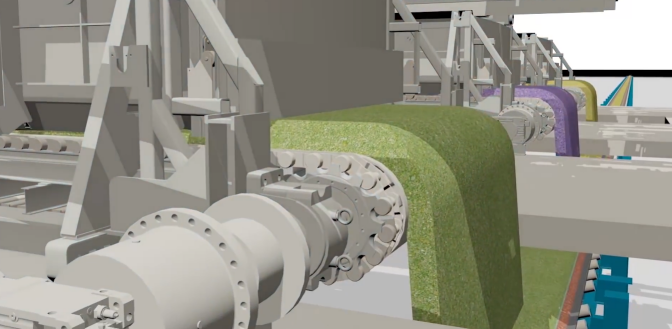
The filter cake produced by the filter press is capable of being conveyed stacked in compact. Waste material with this versatile characteristic. It’s the major benefit of dry tail stacking. When Planning for a wet tailing’s storage facility. A mine plan contains an ongoing maintenance strategy. This also comes with a perpetual cost that can only be guessed that as the decades pass.
A dry tailings handling plant has the goal of ending stacking operations and rehabilitating the stacking area to match the surrounding environment. After dewatering is complete, and the filter cake is deposited on the hybrid apron belt feeder, the material is transported via conveyor to the stacking area. Filter cake can be conveyed using trough or pipe conveyors depending on the application defined in the mind plan.

2. Dry Tail handling Process
Conventionally trough conveyors are the most used form of conveyor, increasingly desirable technology is the use of pipe conveyors. Pipe conveyors provide additional functionality in that the material is completely enclosed in a pipe conveyor.
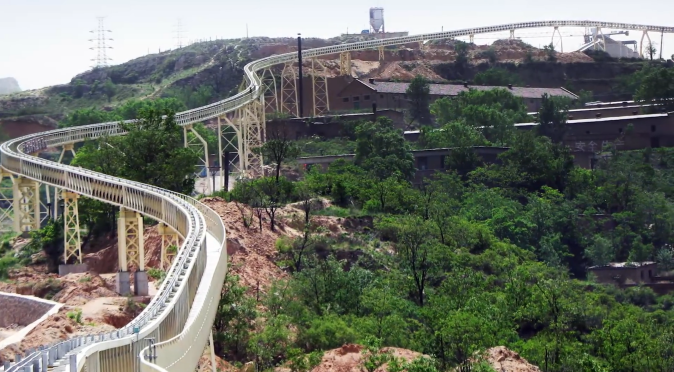
Pipe conveyors easily transverse difficult undulating surfaces in multiple directions, eliminating transfer points, and are the most environmentally sensitive method of material transfer over long distances. The stacking area is smaller than required for wet tailings ponds. The inherent stability of the dry stack material allows it to be stacked to much greater heights, thereby creating a smaller footprint. Perimeter lifts are not required around stack materials as they are with wet impoundment facilities.
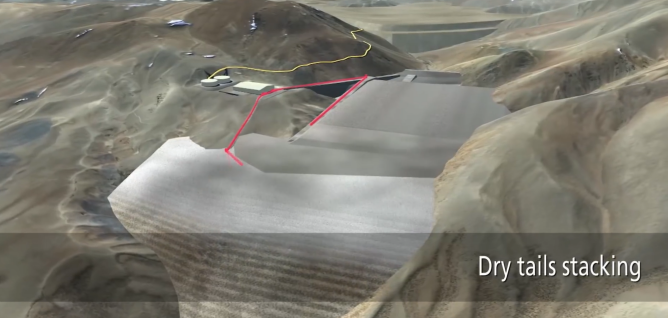
At the stacking area the most implemented stacking devices are either a mobile stacking conveyor, or a boom spreader. While they both perform a similar function in that they discharge dry material to the final resting place. The differences in their applications depend on a mine plan specific requirement.
Waterman Australia mobile stacking conveyors are designed to stack tailings while maintaining a low ground pressure. This system is a long track mounted stacking conveyor that can vary in length from 1500 metres to 800 metres. The mobile stacking conveyors method of laying down material is based on a sweeping process and then adding additional sections to the extendable feed conveyor. As the stacking of the pile progresses. The mobile stacking conveyor can stack both in advanced mode on top of the stockpile depositing material at varying stacking depths, typically 5 to 80 metres deep. It can also stack in retreat mode, allowing it to stack behind itself.

However, in this mode, it is usually limited to a maximum discharge height of approximately 8 metres. These machines ranging capacity from 400 to 10,000 tonnes per hour. As material is stacked, the pile can be contoured to match the surrounding topography. Once a dry stack tailings pile is complete, the pile is rehabilitated with native vegetation to be restored as part of the natural environment.
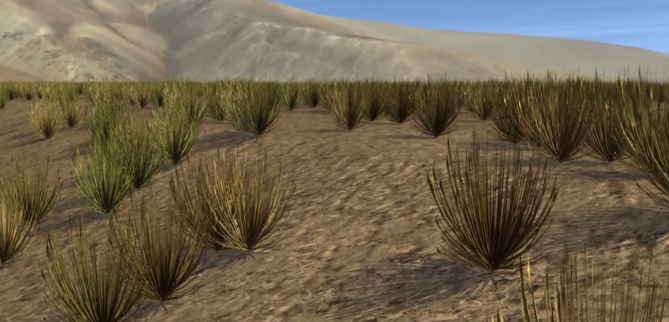
This reduces the environmental impact of the mining operations and improves the social responsibility with residents, governments, and investors. Contact Waterman Australia to find out more how Waterman Australia dried tales stacking technology can improve tailings management.
8- Treatment Plant for Polymetallic Tailings from Concentrator Plants
After the proposal selection process, it was decided to accept the technical solution provided by Waterman engineers Australia Company. The process begins in the sludge reception area where all tailings from different concentrator plants are received. The reception area has five pumps that allow the sludge to be pumped.
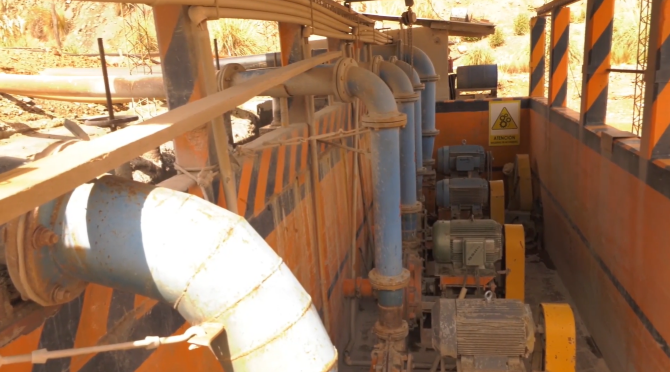
Once there they are stored in a warehouse before being sent to the cyclone plant. The hydro cyclone battery effectively separates the product separating the course material from the find material. The course fraction or underflow is pumped to the vibrating drainer located in the filtration plant a humidity reduction process is carried out in the drainer. From there, the coarse fraction is sent via belt conveyors to the dehydrated material stacking area.
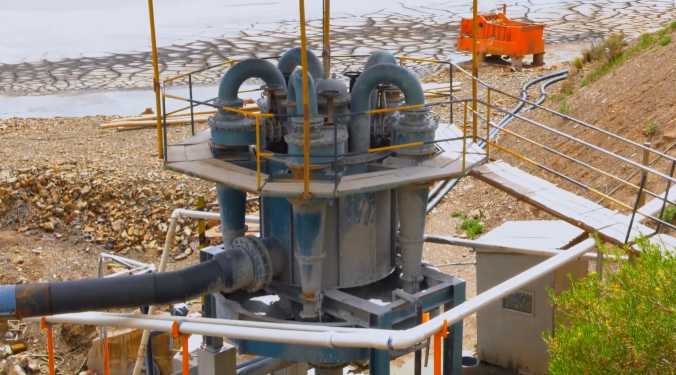
The pulp from the draining process is pumped into the buffer tank for temporary storage and further processing in the filter processes. The overflow coming from the hydro cyclones is sent to the decanters where through a thickening process.
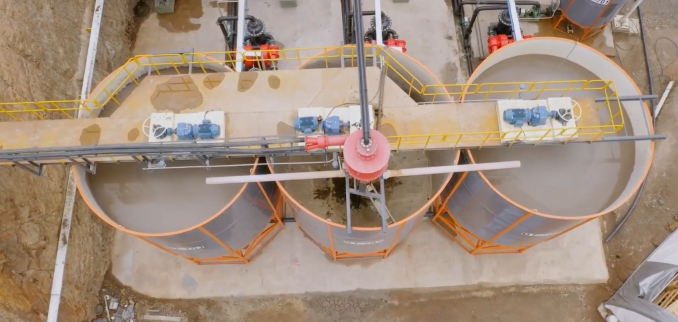
It is concentrated for storage in three buffer tanks. Subsequently, with the help of three bottles, 500 piston membrane pumps, the Pope is pumped to the filter presses where the dehydrated material is obtained, and then transported to the stacking area with conveyor belts. With this project Waterman engineers Australia company keeps consolidating itself as a world leader in technological solutions and process engineering services for mining and environment.

Today Waterman engineers Australia Company collaborates with the most important mining companies and its solutions and equipment have been successfully implemented in the many continents.
9- The Future of Mining Tailings Management
In mining applications, water management is becoming more important. Recent catastrophes from around the globe amply show the risks associated with conventional mining water management. The number of tailings dam failures has increased as a result of unusually severe weather, such as large rainfall or earthquakes, overloading the tailings dam above its design capacity, and poor dam management techniques. Dewatering and dry stacking the tailings would fully eliminate the dangers and problems associated with tailings dams.
Large filter presses are needed to effectively and inexpensively dewater the mining tailings for dry stacking. With an emphasis on lowering operational costs while getting the driest filter cake possible, Waterman Australia filtration of brand of acceptance group has been at the forefront of large filter press development.
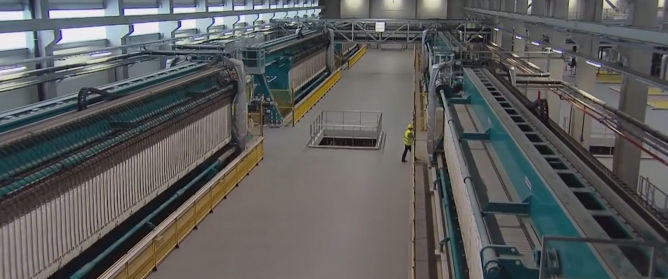
It is safe to stack dry filter cakes that have been produced under high filtration pressures. This is an illustration of a tailings dewatering plant by Waterman Australia. Our client opted to transform their existing tailings dam into a dry stacking facility. A completely automatic stacker, a filter for dewatering buildings, a cake transporting system, and were all installed.
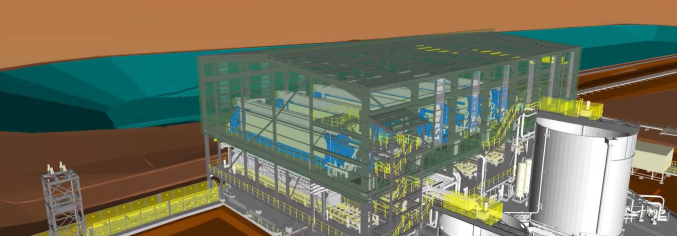
Dry stacking makes site reclamation possible concurrently, which permits quicker and less expensive mine closure as well as lower reclamation bond costs at the beginning of the project.
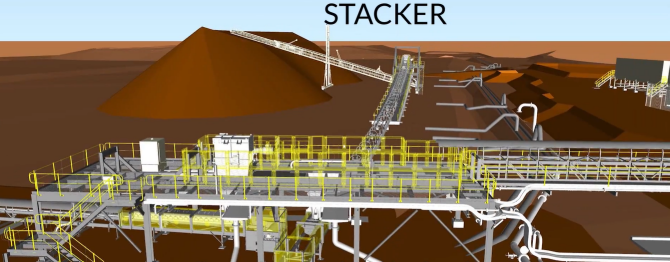
A dry staffing facility has the following benefits:
- There is no engineered dam.
- minimal filtering and seepage
- The moisture required for the best filter cake compaction is present in filtered tailings.
- Improved seismic performance and stability
- reduced long-term water management after closure

Six of our filter presses are used in this facility, and each one can generate compact filter cakes that allow for extremely stable dry stacking of the trash. From the filter press building to the dry stacking area, the filtered cake is transported by conveyor. Here, a stacking conveyor distributes the dry material in rows and a bulldozer compacts the rows. This method uses a small portion of the necessary area while saving 8,000 cubic metres of slurry storage each day. No filtering was done on the tailings.
Mining facilities may now eliminate the risks associated with conventional methods of water management thanks to the application of developing technology and the usage of filter presses made in Australia by Waterman.
10- Tailings Management for Engineers
This is a topic that could take days and days to work through, but in this portion of article we discus some highlights on general tailings management considerations and technologies and then dive into some sort of unique properties and behaviours that we see in tailings versus natural soils. Then talk about how all this works together, and sort of a systems approach followed by some final thoughts.
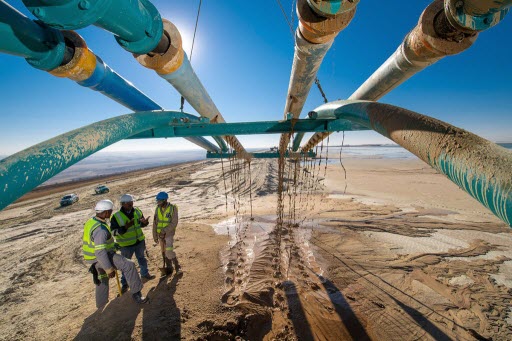
1. The challenges
So, looking at tailings management itself, what is the challenge. The tailings are unique and that all mines are different, we have different or types. Different geology is no one combination of tailings technology or management is considered best you hear the words, best achievable technologies, best available technologies. But pretty much we need to look at each specific site. Everything also varies spatially, and, and temporally in the ore as well as the tailings that are produced out of that.
There’s this constantly evolving situation that we must be monitoring and dealing with in our design and then operations. I want to talk a little bit about how the parts of the system affect tailings management. So, from the pit all at attendings facility and vice versa. Then when you’re looking at design of a tailing’s facility, how do you start when you can’t observe things to scale? As far as having a working system in front of you. What do you do with the initial assumptions for the design process.
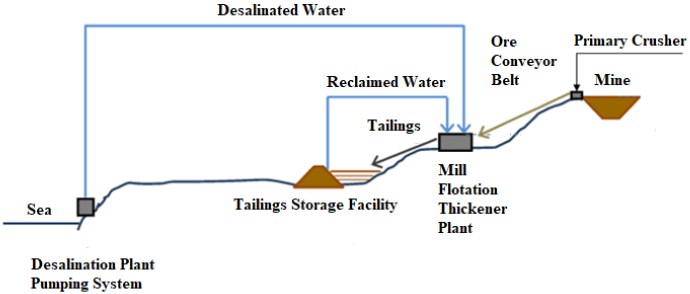
2. The Expectation
Looking at the expectation for tailings management, a global industry standard on tailings management, which was introduced last year and just looking at topic three of that of it. There’s a lot of really great stuff for those that are in the tailing’s world. This is probably sitting next to your bed.
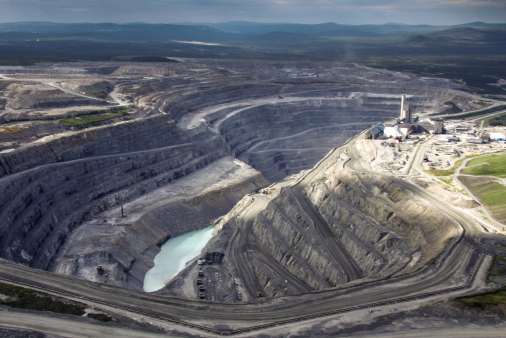
But for those who aren’t familiar with it, encourage you to look up the global tailings review and download a copy some of the key principles and just going to look at topic three here design construction operation and monitoring of the tailings facility really focuses around minimising risk from setting the design criteria developing a robust design, the idea of developing a knowledge base, looking at the whole tailings lifecycle, then getting into planning, building and operating your tailings facility to manage risk and minimise risk.
Then what type of systems would you design, implement, and operate to manage risk throughout all those life phases. The global tailing standard is a great reference to look at management of tailings facilities as well as other management groups such as mining Association of Canada has a lot of good information in their guide to managing tailings facilities.
3. Tailing Management Considerations
When we dive into tailings management considerations, and this is such a topic unto itself, but we wanted to throw in kind of a bit of a primer here of what we look at for siting or developing a tailings facility or management scheme, we need to look at everything that the type of mine, the scale of the mine, what are the site conditions, these are physical, environmental conditions, what type of technology is used is available for and what type of facility we’re gonna get into different types of facilities and a second.
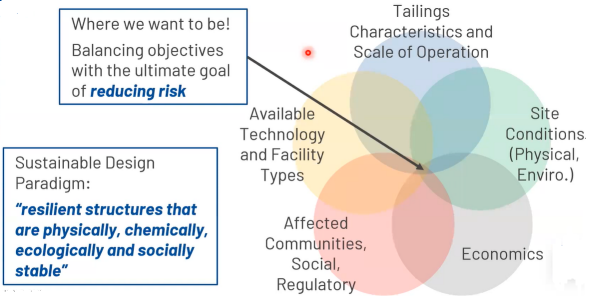
We also need to look at, obviously, all the affected communities, what’s the social environment, the regulatory environment, and then the overall economics and really in this Venn diagram is the sweet spot is right in that centre where everything overlaps is where we want to be balancing all of these objectives really what that ultimate goal of reducing or minimising risk, which is bad expectation from the global tailing community.
4. What is best achievable technology?
We’ve heard the term best available technology best achievable technology, sometimes it’s best available techniques you hear best practical means best practicable environmental option, a lot of terminology out there, but I think the expert review panel from the MT Polley dam failure from 2015, set it relatively well related to tailings BAT and they were really looking at the sense of water in the whole equation and the three points they came up with for BAT for tailings is eliminate surface water from the impoundment.
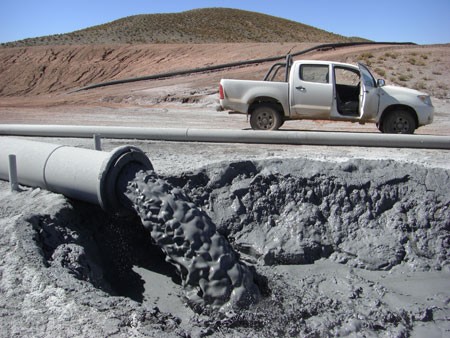
Don’t use your facility to route all of your surface water from mind through your tailing’s facility promote on saturated conditions in the tailings with drainage provisions. This is where water, everything comes down to water you need to get the water out of the tailings. This is for a strength point of view, it gives you increased storage, you really need to get desaturated or drain out down behaviour and your tailings. Some of this is related to the dams, but we’ll just talk about tailings in general. Then the idea of achieving dilating conditions through tailings deposit by compaction, and this is the idea of compacted tailings stacks, filter tailings, those sorts of things. So really, everything is all about water.
One of the aspects of is involves communicating with communities. One of the simplest ways that we can put it in I believe that this, there’s always exceptions to everything and having water covers. But dry equals Safe is a key message to give back to communities. Another one is kept clean, water clean. These are simple messages that we can use to communicate with all the communities of interest around a minor a tailings facility dry will safe keep waters clean these are some basic principles that we can work around.
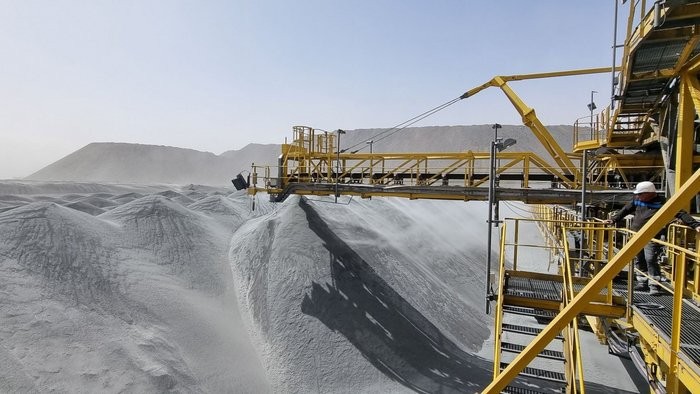
5. Technical Considerations
But we discus some technical considerations, we could go into physical considerations of a site and geometries and types of dams and all different technologies. I’m not going to get into various dams in the geotechnical aspects of those. But I really want to just talk about
- Tailings characteristics and
- A little bit about the scale of the operation.
So really thinking about these physical properties of what are the tailings doing, how are they depositing? What type of brain characteristics do we have in this and unique behaviours from ground rock that I’d like to share with everybody today. Also, briefly touch on chemical properties. Then ultimately, all this factors into that mill production rate and what kind of throughput we get through the facility because that’ll dictate the scale of the operation.
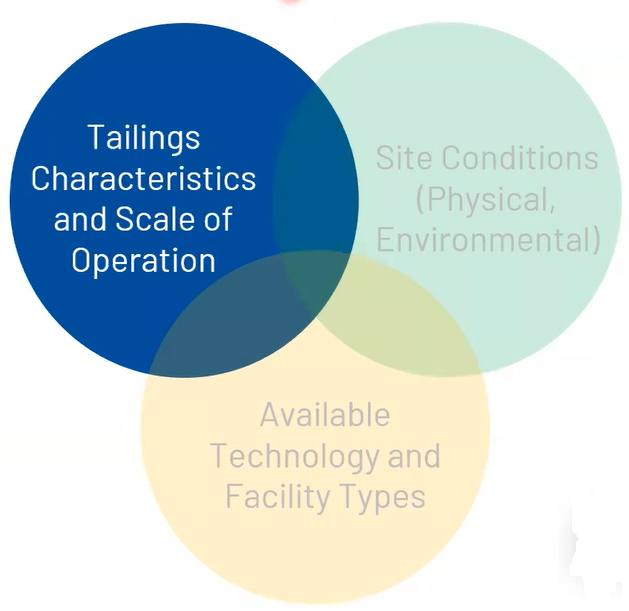
6. Tailing Dewatering Technology
From just at a high-level tailing, dewatering technologies, again, it’s all about all about water. So, removing water from the tailings as it comes out of the end of the mill, you really get into three main areas of, of dewatering technology, you get your standard conventional tailings facility where you almost have a straight on thickened slurry from the end of end of the mill, to typically running at a low solids content around 30 to 40%, range and solids content.
Then we start to thicken it up from there and as you thicken it up, it really increases the yield strength of the material, you can start to stand on its own. You can see some examples below figure. you can see you’re getting into thicken and paste where you’re starting to get into almost like a toothpaste whipped cream type consistency as an icing there. Then all the way once you break into that barrier where it’s no longer really behaving like a liquid and you’re working with a solid and this is your filter, your filter presses vacuum filters, and getting into there’s an example of brown sugar here, we need to deal with it mechanically like you would a solid.
A. Surface Tailing Facility Types
1. Conventional
We’ll look at briefly a few sorts of general schematics of those three types of systems and just some high-level ideas around them. They’re the primary example is conventional tailings.
This is the most common around the world. It tends to take up the largest footprint because you’re dealing with a large impoundment usually has a large amount of water behind it the and thickened or slightly thick and slurry is discharged usually from the top of a dam, you need a dam to impound the tailings. These areas could be subject to liquefaction because of the positive so loosely.
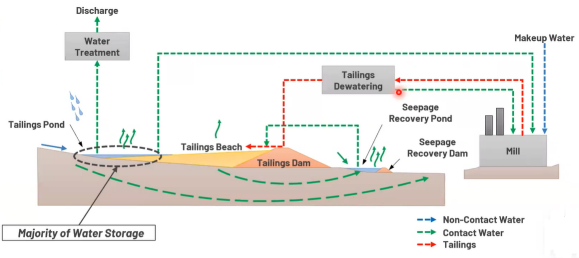
Usually, we’re trying to get tailings beach out in front of the tailings dam. Then we remainder of the tailings go below water in the back. And there’s various options of this depending on what type of geochemistry you have. But in general, this is the most or has been the most economical solution. But that’s sort of changing as we move forward in mining world is that we’re starting to see other technologies become more competitive. This ultimately is coming down to the scale there’s large scales, this is very economical, but when you get down to smaller scales is when the other technologies really come in.
2. Paste/HD Thickened
Looking at paste and thicken, you have a similar scenario, where you have the thicker material still contain behind a dam and a lot of cases this is a perimeter dam, usually you have some sort of central deposition point this is showing a side hill deposition where it flows down against the perimeter embankment. The water that is carried with it is decanted over into some sort of polishing and recovery pond, which goes back into the mill process system. In this case, you can usually get some steeper slopes associated with your tailings deposition because you’re working with a much higher solids content, but you still have some of the same problems where this material is you Usually prone to liquefaction there’s usually a large area where it’s saturated.
You still have a lot of geotechnical considerations to work with this. Then you have to look at different closure technologies, because a lot of this will be exposed to closure versus being under some sort of water cover. Usually, you also have to have a large secondary dam for your all your additional water for the process needs. So, you could be introducing another liability here by having a second dam.
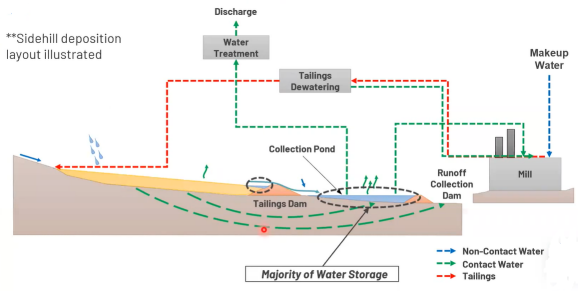
3. Filtered
Going to that far end of the spectrum is really that filter tailings technology, which is seems to be quite effective at lower tonnage is we’re talking in the thing that sort of 310,000 tonnes per day type of operation, some areas are going better than that, when you’re looking at 100,000 tonne per day mine or larger, this sort of technology starts to start to be cost prohibitive. One of the one of the key aspects and this was from the power report of this idea of compacting the tailings generating something that doesn’t liquefy that’s a non we call non flammable.
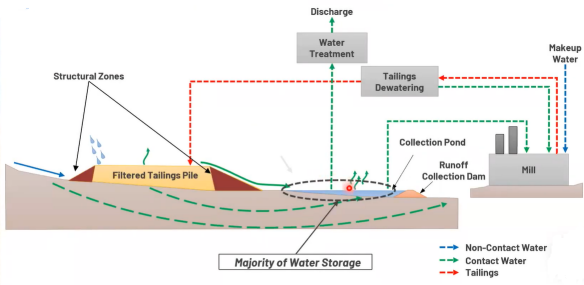
Type of situation typically involves having a structural more compacted outer zone to your tailings pile. Then weather conditions, there’s various filter piles in northern climates where you have winter construction in the centre, and then summer construction and your structural zones in the outside. This usually also has a need to have surface water drainage around it and another secondary pond to provide the mill process needs.
So again, having us another small dam with your filter tailings pile is usually required, the costs are going up when you’re running filter presses. But there’s starting to be a lot of economical applications throughout the world. Typically, in underground gold mines and that sort of thing.
B- Unique but important behaviours of ground look
The idea of behaviours and properties of tailings and I kind of throw this out there as calling it behaviours of ground rock. A bunch of this will focus on copper tailings. But there’s some of these behaviours are applicable to other tailings as well. But I’ve just got some good data here to show some copper examples.
We like to look at all these wonderful things we can measure in the lab, and then we apply them out to a tailings design, but we need to look at what how do we link between what we can measure, and what we can observe in the field. This is going to come back after this section and talk about the idea of Plan, Do Check Act and validating your assumptions with measurements in the field. How do we approach this whole idea of managing change.
Because tailings as mentioned, are really changing over time, they’re changing as the as the mind changes, they’re changing around your tailing’s facility at different times of year. So, we’ve got to account for all of this. As we design and operate facilities, we’ll look a little bit at grain size, some general grain sizes of tailings and then also some shear strength and permeability data and how that relates to deposition and behaviour.
A couple key things is looking at these things that you can observe and thinking about what you’re going to track in the operation, you need to start thinking at the design stage about key performance indicators (KPIs), what type of things you’re going to put thresholds or values on that you want to check, as you come back to do you want to look at a certain depositional slope.
If you don’t achieve that depositional slope, come back to your grain sizes, come back to your milling parameters. If you’re looking at densities, how’s that behaving? Is there some sort of critical number that you need for sizing your facility and then there’s other considerations, thinking about desiccation and dusting, how that impacts your facility, cracking of the tailings surface, all that sort of stuff.
C- Tailings Gradations
These are just some generic envelopes for tailings looking at coarse tailings. Here’s in below the figure sand sizes, then getting into hard rock alternative rock, fine tailings, ultra fine tailings here below figure you’re getting these mature, refined tailings and the oil sands up in this area. A lot of copper gold tailings in this sort of middle range here. Then you look at what kind of plasticity you will get where do we get clay mineralogy and usually that’s in these ultra fine tailings.
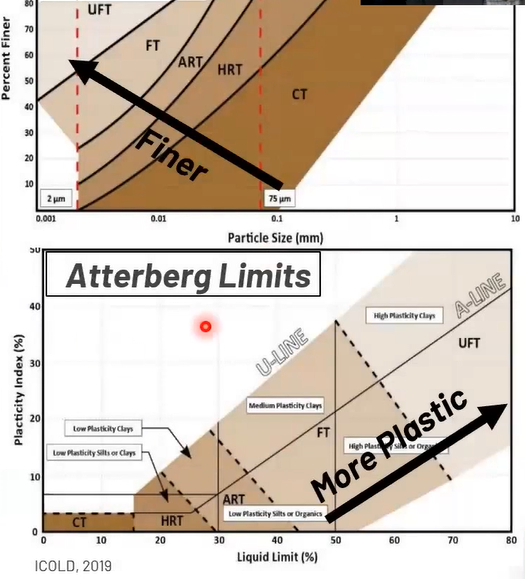
Then in some of the finer tailings and altered rock towns, we can get into low plasticity cells. We’ve got a lot of ranges of behaviours. One size does not fit all on these, these tailings facilities. If we have something that’s ground up fine as far as a gold tailing vs high throughput copper tailings when you’re looking at more these core sands.
D- Tailings Chemistry
At the same time, we must consider tailings chemistry. A lot of good work is done through the various ARD communities.
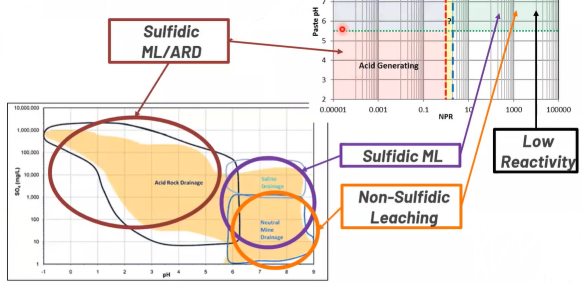
When we’re looking at tailings there’s usually with if they’re tailings or acid generating, you cover them with water. It’s kind of a generic solution, where they’re starting to see more and more work in how can we get to these drier surface landscapes without full pools on top of them at the end? How can we incorporate that in the idea of acid generation in these designs, we really want to look at how do we manage the tailings ponds.
One example of this in a copper facility where we have sulphate coming out of the cleaner tailings is the isolate your high sulphide tailings separate from your refer tailings and keep them into different areas of your facility.
So, they’re starting to be management approaches to separate out things that are geo chemically a problem from the areas where you can keep them dry and achieve those sorts of tenants of that from that hiring recommendations.
E- Particle size classification by cycloning
I just want to give a bit of a show here to Sand cyclone as a technology. This is something that’s really front and centre. Our record for a couple of Cyclone sand tailings dams.
This is a really nice way of working with copper tailings especially known as a generating copper tailing where we can separate out the coarse fraction of the tailings and use it as a construction material. Rather than borrowing large quantities of Earth fail or using rock fail to create dam. We can I’m not going to get into dam construction here below figure. But just want to show some examples here of when you can separate out who are stealing sands from these lines, put these lines in the centre of the facility and stack the sand to create a great new dam shell.

F- The Impact of Deposition
Then mentioned in the beginning that it’s all about water. The next want to talk about the impact of deposition. What does that mean for some of these engineering parameters. These are just some schematics, some older schematics of tailings beginning off an embankment. One of the key messages is what is this due to permeability or hydraulic conductivity of your materials.
As the solids come out of the pipe and flow across this tailings beach, you start to get the heavier particles falling out first. So, this is where you get high permeability sands and then you start to get a transition zone where it gets dirtier until you get to low permeability slime. So, you start to get this natural segregation of material across a beach.
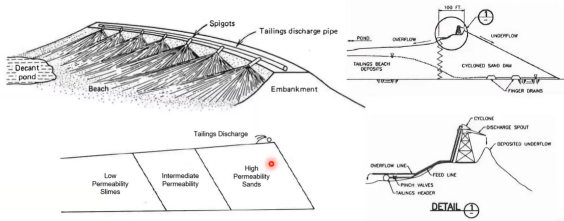
If you have a tailings facility that doesn’t have sub aerial or above water beaching, you lose this whole process and you end up getting fine material right in against your dam. These have been some of the problem areas with upstream constructed dams that we’ve seen around the world is where you get these decant ponds coming right up to your dams in areas of the operation, which can lead to these low permeability slimes coming right into your dam.
The key aspect of tailings management in my opinion is having large beaches. There are numerous areas in the world where you’re dealing with lots of water and you have to manage all of these things together. But if you can have large beaches, lots of freeboard, drain shells to me, those are the simple things that you look for in in a tailing’s facility Again, dry = safe. Just an example here on the right of a cyclone sand dam relatively generic where you’ve got this large sand zone that’s been created through cycloning and the overflow out of the Cyclones with all the slimes is coming out into a pond a long way away.
You by doing this with this method and having the natural segregation of the beach, you end up getting a really low water table throughout your facility. This is targeting that really nice and dry drain shell is gonna provide you all your support for your facility.
D- Hydraulic Conductivity
Looking at some hard data on numbers here, this is a bunch of field testing with a little bit of lab testing on hydraulic conductivity for copper tailing sands.
One thing that’s really interesting is that because you the sand has very low clay content, we tend to get a very consistent measure of hydraulic conductivity around 10 to the minus five and this is in metres per second not feet per second but 10 to the minus five metres per second consistently over and over.

Independent somewhat of the finds content now finds content is defined as the percent passing a 200 sieve and you can see this it’s kind of bobbing around in the area. As we look at hole tailings with, say 45, 50%, fines for a copper hole tailing, you start to get down to 10 to the minus 6, 10 to minus seven, and your slimes are down in the 10 to the minus eight, this is everything, passing a 200 sieve, you’re down in that 10 to the minus eight or so range and hydraulic conductivity.
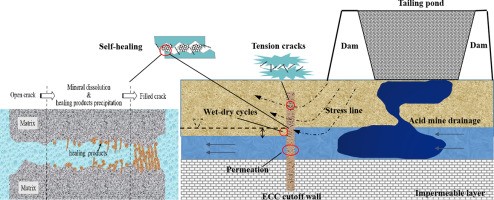
When we look at hydraulic conductivity as a parameter, and then how do we really measure these using fines content alone is not the best way to control this, a lot of operations will specify their dams are made out of Cyclone sand, we just put a hard limit on 15% fines, because that’s going to give us the drainage that we want.
When you get all the data together, and you started looking at it, there doesn’t seem to be much difference between whether it’s 15, or 20, or 25% fines, there’s a lot of operational challenges when you start to change those numbers. But from a straight mechanics point of view, it doesn’t seem to vary that much.
It’s better to actually look at the clay size or starting to look at the 10-percentile diameter of the particle as an indicator that’s consistent with the formulation of Hasan’s formula where it’s the 10 percentile diameter squared times a constant just to get it into metric units.
But it’s a very good correlation, that’s this diagonal line in above figure, you can see that it fits reasonably well, in all of these materials. Now, this typically doesn’t have a lot of class, as you start to increase the clay content, you’re really going to see the D 10 move around and get and get finer, you’ll start to see a lot of change in the hydraulic conductivity. But from when you’re looking at general cyclone construction materials, there’s not a lot of variation.
These dark dots on above figure actually represent lab permeameter tests of samples with these finds contents and you can see that the lab matches the field which is the open circles measured in a combination of double reading and photometers or more Guelph permeameter, so a lot of good comparison and different methods.
H- Settled Density
Again, with deposition settled, density becomes a very important parameter. Really in the sense of sizing your facility. How much tailings can you get in a facility is dependent on how dense you can get it. As you get with compacted materials such as filter tailings, you can get over 110 pounds per cubic foot or up in that 1.9 tonne per cubic metre range.
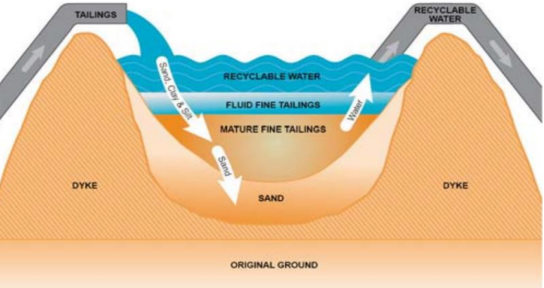
With sands the cyclone sands you can get around the 105 pounds per cubic foot. When you’re looking at just the straight slimes or sub aqueous whole tailings, you’re down in the 75 pounds per cubic foot. So, you can see there’s a big range as far as the density whether or not you’re depositing below water or you’re able to classify your material and get it in a denser state on a embankment or even on a on a beach.
So, is an area showing below in figure where beaching becomes very important and having large pizzas you can increase your density separate from just classification of materials you have a density increase usually with depth so as your tanning facility gets higher and higher, you get more consolidation, self weight consolidation of your tailings as you go up, so you need to factor that into your design.
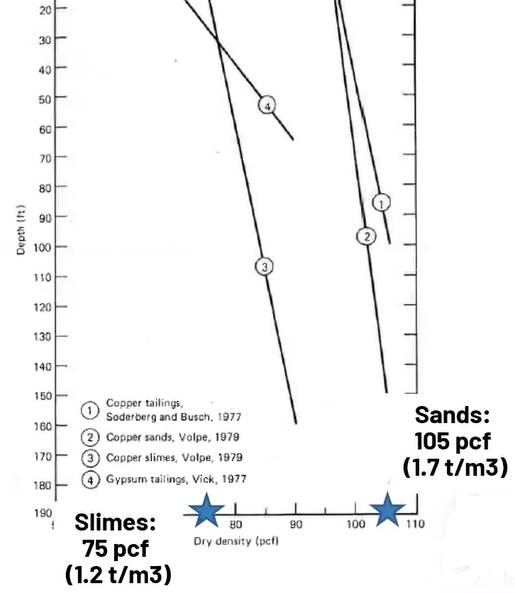
Ultimately, this comes back of what how you size your crust raises, how you size your starter facilities. Then checking these numbers is important too, as you go year by year to maintain whether your assumptions are valid.
I- Angularity
Along with that cyclone discussion, I want to just throw up some photographs of angularity. These are again copper tailings the one on the right being hauled tailings these were sampled from a legacy facility. This one down at 100 metres depth in some older hole tailings this at around 75 metres depth in more just the cyclone size. Now the scales are slightly different. You can see 100 microns versus 200 microns. But the point I want to make is you can look at the angularity.
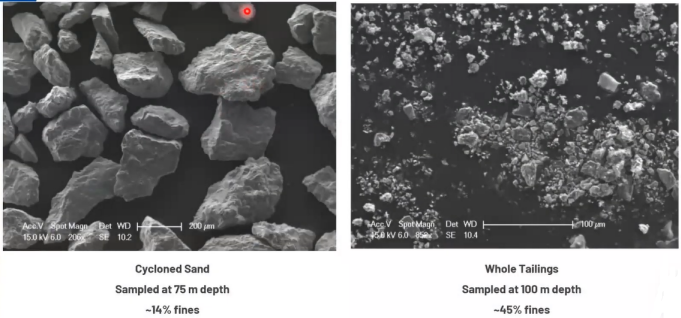
These tailings are about 30 years old. You can see that even at 75 to 100 metres depth, you’re not getting grain crushing, you’re still getting quite sharp sides to the particles. This really has a high impact on strength determination. You can one thing with ground rock is not like a natural soil where it’s tumbled down a river valley, we really have to consider angularity in our strength parameters and one example of that again, copper tailing sands.
We’ve done a lot of testing this is just a snapshot of it of different consolidations and conditions, but we tend to Get around a 39-degree friction angle for these tests here we’ve done a lot of other tests with different finds contents even hold tailings, 50% tailings at 35-degree friction angle.
We get a range much higher than natural soils. If you were to look at a river sand, one very prominent river sand in British Columbia is Fraser River sand, and it typically is around the 32-degree mark down in here. You can see just that angularity really gives us a bump up in frictional strength and we see this not only with the coarse particles, but also in the finer particles as well.
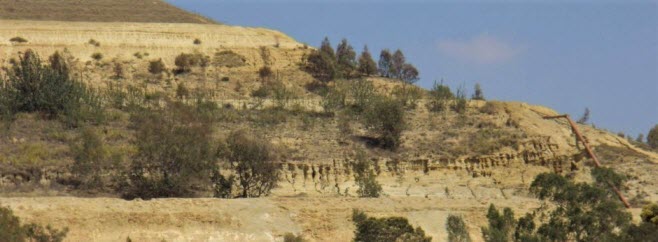
When we look at gold tailings or silver tailings, a lot of times were a much lower number somewhere around the 25-to-28-degree friction angle but still relatively strong. Considering that it is almost entirely finds entirely finer than 75 microns. Usually, we end up with decent strengths for the construction materials, or even the tailings behind it, the key comes down to water and the key comes down to density.

If you’re going to deposit cyclone sand directly onto a dam, where you’re not compacting it. So, it would not be in some sort of cell construction, then you’re looking at this as a good friction angle, but the material must be drained, it has to be desaturated. If you’re building something that has the same type of sand, and it’s compacted in place, then you’re still going to get a very similar friction angle, but you’re not as concerned about liquefaction of the sand fill itself.
So, these are these are considerations that you must do when you’re setting your facility and defining your drainage elements of what type of facility behaviour you want, whether or not you need to compact everything, or you can go with an unconnected high drainage type of design. Those are just some shots at some engineering parameters like
- Hydraulic
- Conductivity,
- Friction
- Angle density etc.
They’re all variable with time depending on how the mind operation changes, whether or not something changes in the mill and affects what type of grind you get. But how do we deal with this when we don’t have this to start with, we’ve got a huge database of minds out there, we’ve got a lot of good parameters to start with.
But we really need to link things that we put in our designs to things that we can measure in the field. So, we usually do some sort of seepage model and throw in some nice parameters for saturated hydraulic conductivity, and then throw a fines content specification on material and all those good.
We need to be able to go out and check that we need to measure those fines contents in the field we need to do in situ permeability testing, not just lab-based permeability testing. we need to think about how do we go from material deposited as a hydraulic fail to a density number which is what we can test in the field with a nuclear densitometer? Then what does that really mean in terms of a frictional strength or stability model? These are all things where we need to set targets and then be able to check those targets. We need to look at the range of those parameters and think about what is the upper bound what is our expected behaviour.
11- How can we improve mine tailings processing, management, and disposal
Tailing is becoming more of an issue as far as disposal goes, the storage of them so to efficiently do that, in a way that safely environment and safe for people is extremely important. The relationship with rare minerals is very strong with most of the customers says certainly product experts but with the weird technical centres were getting far more involved in the actual process.
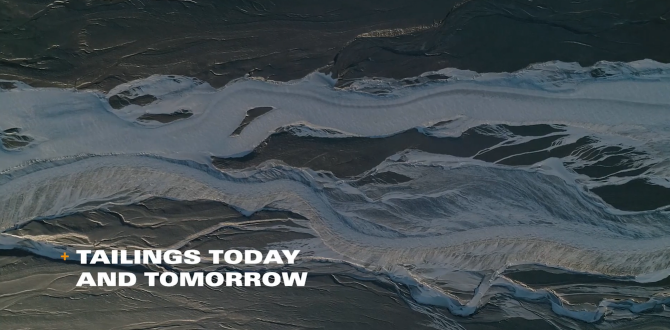
The where technical centre is involved in delivering the customers and innovative solution that saves the money. The work that is being carried out at the waterman engineers Australia is all about saving water utilising less water and having less effect upon the nature and the environment in which we work.
Dry pumping provides a much slower storage footprint. We’re pumping a much drier product and because the mods are running out of space in some of these terms, it’s important that we go demonstrate.
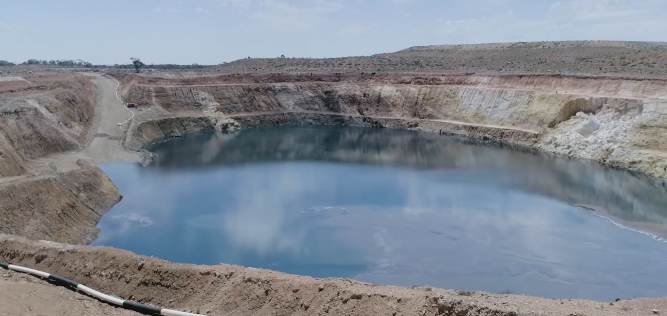
We’re also looking at different ways of how you could actually reuse or have an alternative use of tailings We start to look to use tailings more in backfills of roads construction materials. We’re also looking at ways whether you might potentially recover more of the valuable product from the tailings that haven’t been recovered before. So that’s what we call tailings as a resource.
Each customer that comes to us has a different type of slurry has different type of problems. Each of those slurries will have different wear characteristics, different hazards involved in it, and we work to eliminate those hazards and make sure that the customer doesn’t have to worry in the future. absolutely proud of what I do making mining safer, making it better for the environment is extremely important. we minerals has been doing that for the last 50 years.
12- Waterman Engineers Australia Project’s Tailings Management Facility
The TMF is designed to minimise long term environmental impacts by the proper storage of the mine waste which is called tailings. Tunnels built through and ditches built along the valley walls will collect uphill water runoff and diverted around the tailings management facility. Since this water is diverted before contacting the tailings Management Facility. It’s same natural water that is always float off the mountains and it will not impact the fish living downstream.
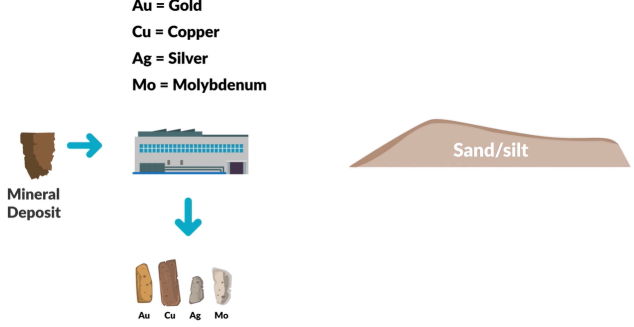
After the mined rocks had been processed and the metals removed, the leftover waste material is essentially sand and silt. It is called tailings. Tailings are stored in the tailings Management Facility. The Waterman engineers Australia tailings management facility has been designed using best available tailings technology or BATT, which focuses on both physical and geochemical stability and ensures the environment is protected.
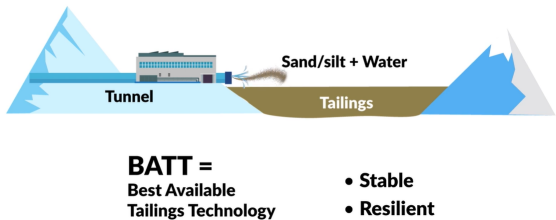
It is important to remember that best available tailings technology is not a single technology. It is a technological design based on site specific details that results in a stable and resilient TMF. For Waterman engineers Australia tailings management facility will fit within an already formed Valley which provides natural containment for the material that will hold. It will have three independent cells designed to store the tailings in a responsible and safe manner. About 10% of the total tailing’s material could be acid generating and could potentially cause environmental impacts.
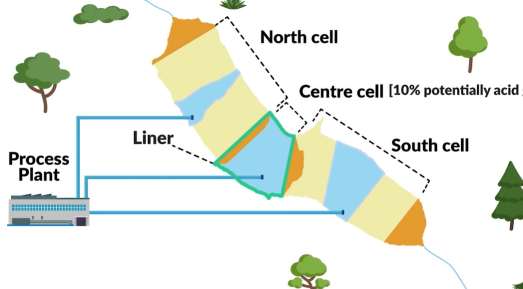
The remaining 90% consists of sand and silt and is benign. We are planning to carefully contain the potentially acidic material in aligned centre cell. This cell will be isolated from the main portion of the tailings management facility and the natural environment. Waterman Engineers Australia is tailings management facility is designed to incorporate best available tailings technology, the facility will be constructed before the mind begins operation.
Over the life of the mine construction will be done in stages to minimise disturbance and potential environmental impacts. Tailings will be retained by four dams constructed out of compacted cyclone sand built on top of compacted zoned Earth fill starter dams, compacted cyclone sand is tailings with water removed.
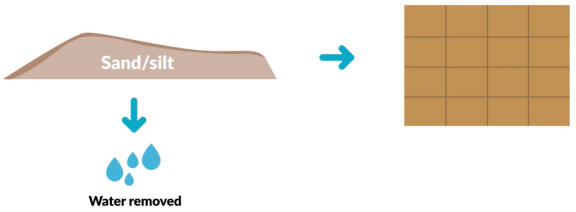
It is essentially a form of dry stacking. Some dams at other mineral projects are constructed with earth fill in bank mints. But in the case of Waterman engineers Australia cyclone sand is a stronger, safer, and more stable choice offering greater protection against earthquakes over the long term.

A good example of a dam built out of Cyclone sand is at the currently operating Highland Valley mine located in central British Columbia, which has been operating for more than 30 years. Waterman engineers Australia has four dams will range from an initial height of 25 metres to more than 200 metres at the end of mines life.

This will not be the largest cyclone sand dam in the world. There are higher dams located in South America, which is far more prone to earthquakes. Long term outer dam slopes are constructed at a three to one grade. A gentle slope like this one is an important design feature when assessing the long-term safety of any dam.
Waterman engineers Australia tailings management facility was environmentally assessed for discharge. So, each year we will release environmentally acceptable excess water into the natural environment. This discharge will be released to mimic the natural flow of water volume in nearby waterways and there will be no harm to fish living downstream or impacts to the water quality.
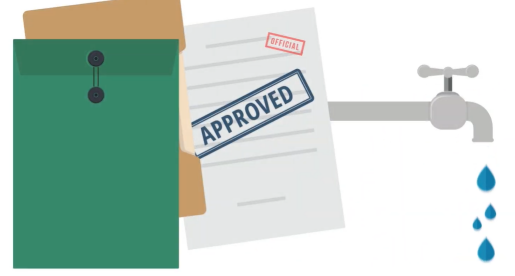
During operations. We will ensure accumulated water remains kilometres away from the dams at each end of the facility. Maintaining a free water pond away from embankments is key to ensuring long term dam stability. The tailings management facility will contain extensive de watering systems to mitigate pressure that may build up within the structure.
After closure the tailings management facility has room to hold more water than a 30-day rainfall with an accompanying snow melt which is the largest storm possible that could occur once in 10,000 years. Should this happen after the end of mine life spillway channels will allow clean water to flow out of the facility without causing structural harm.
Waterman engineers Australia received its environmental approvals to proceed. The assessment took seven years to complete. Almost 10,000 pages of research and technical information was produced, and more than 150 scientists’ engineers, indigenous technical experts and regulators developed and carefully reviewed the information. More than 4,000 people from many countries participated in public meetings, consultations and project information sessions before the proposal was approved.
Many mines in many countries are much larger. Comparable sized projects are also being safely operated in Waterman engineers Australia tailings management facility design has been evaluated by a fully independent, experienced, and technically qualified.
This group continues to provide independent expert oversight opinion and advice to waterman Australia on the design, construction, operational management, and ultimate closure of Waterman engineers Australia tailings management facility. Many years from now when it comes time to close the mine, we will do several things to ensure continued safety and stability of the tailings management facility.
We will place boulders to provide long term protection on the dam faces plant natural ground cover on the tailing’s beaches build additional spillways in the stable rock at the ends of the facility and allow excess water to flow out over the spillways. We will store only a minimal amount of water in the facility over the long term.

Finally, we will regularly and continually monitor the tailings Management Facility far into the future. We committed to responsible and sustainable operations now and in the future in all communities in which we operate. To learn more about the Waterman Engineers Australia project and its tailings Management Facility, please visit www.watermanaustralia.com
Frequestly Asked Questions on Tailings Storage Facility, TSF, or Tailings Management Facility, TMF
Exactly why are tailings dams required?
To store mine waste like tailings and waste rock for extended periods of time, structures called tailings dams, or tailings management facilities (TMF), are necessary. Mining waste must be kept behind a dam so that it doesn’t get into waterways and make them dirty.
Why is it important to manage tailings?
Infrastructure, the environment, human health, and safety, as well as the mining companies themselves, may all be at risk if tailings storage facilities are not handled properly. Effective tailings storage facility management is essential to minimising and reducing these dangers.
What is a tailings impoundment?
In order to increase metal recovery, a mine operator may choose to process high-grade ore in tanks as opposed to using a heap leach method. After the ore has been coarsely crushed, metals are extracted from it using a slurry made of water, chemicals, and crushed rock.
What distinguishes mine waste from tailings?
Waste rock is bedrock that has been removed from the pit and moved outdoors but does not have significant concentrations of valuable metals.
Tailings are the finely ground by-products of milling that are still present after the important metals have been removed from the ore.
What is the life cycle of the tailing storage facility, TSF?
Tailings dams undergo change during the planning, design, construction, operation, closure, and post-closure stages. There may also be care and maintenance stages in between operational phases. The closure phase of a tailings dam’s life cycle can commonly go on longer than the operational phase.
What environmental problems are tailings responsible for?
Multiple environmental problems can be caused by large tailings piles, including sloughs and landslides, Instable tailing piles are susceptible to landslides. The wind carries dust and other tiny particles found in dry tailing deposits, which are subsequently deposited on nearby populations before being transferred once more by leaching.
What makes tailings potentially problematic?
The possibility exists for the contamination of aquatic life by heavy metals and milling chemicals contained in tailings. Some metals, especially mercury, have the potential to bioaccumulate and harm people by migrating up the food chain. Low oxygen levels and turbidity, which is when particles in the water make it look dirty, are bad for aquatic life.
Which process results in tailings?
After the ore body has been removed, processed, and valuable metals and minerals have been extracted, the remaining waste material is called tailings. Mine tailings are the waste products generated during the mining, crushing, grinding, and chemical processing of ore.
What is achieved by tailing?
In tailings ponds, waste from separating minerals from rocks and slurry from mining tar sands are kept. The release of polluted water into the environment can be slowed by mixing tailings with bentonite or other compounds to create a thicker slurry.
How are tailings waste materials stored?
Typically, tailings waste is stored behind gigantic dams that can reach heights of hundreds of metres. These dams are built gradually over many years, using waste from the mine. When tailings dams fail, a massive tsunami of trash and contaminated water is discharged, which has the potential to destroy communities and ecosystems.
How might tailings’ impacts be mitigated?
Backfilling helps to manage the risk of working collapse and subsidence following closure as well as the working of the ore body close to a worked-out stope. When the mine is shut down, the local groundwater level will rise, preventing acidification and preventing tailings from inhaling air.
What ingredients are in tailings?
The dangerous elements present in tailing ponds, such as arsenic, cyanide, mercury waste, and other heavy metals, have an adverse effect on the environment and human health.
Tailings: Are they considered hazardous waste?
These wastes are classified as hazardous by the UNEP, and their enormous volume makes environmental measures necessary to optimise their management.
Why might a tailings storage facility malfunction?
Most of the failures of the tailing’s storage facilities being looked at can be traced back to a few problems, including a lack of continuity in management and not having enough resources (especially money) for the facility.
What potential causes of tailing dam failure are there?
Most tailings dams fail because of three things: overtopping, static liquefaction, and dynamic liquefaction.
What are tailings’ negative effects?
With effluent and dust emissions that could be dangerous for people, animals, or plants, tailings can have long-term, severe consequences on the environment, human health, and safety if they are not properly handled.
What is a tailings thickener?
Tailings Thickeners are used to remove suspended particles and put clean water back into the operation. The high suspended particle loading in the return water can have a significant negative influence on the plant’s ability to function.
Can tailings be recycled?
Recycling mine trash in this situation can reduce the amount of waste that needs to be disposed of. The mining and metal extraction sectors have pointed to emerging solutions such as the circular economy, recyclability, recycling, and reuse as the main drivers of the many elements of sustainability.
What types of tailing exist?
The three basic types are centreline, downstream, and upstream tailings dams.
What issues do the tailings have?
Two main alternatives to the conventional methods of tailings disposal are now used in some situations for the surface disposal of mine tailings. For surface deposition and dry stacking (or dewatered stockpiling) Cemented tailings paste is being used commonly.
What traits do tailings possess?
Tailings frequently exhibit low to moderate hydraulic conductivity, high water content, and porosity as compared to soil. Even though ICOLD said that the shear strength was low to moderate, it was measured against natural materials and found to be moderate to high.
What is the specific gravity of the tailings?
Except for iron ore and taconite tailings, the majority of which have specific gravities below 3.0, it appears that mill tailings have a range of specific gravities between 2.60 and 3.35. When dry rodded, most mill tailings should weigh between 90 and 135 lb/ft3 (1450 to 2200 kg/m33).
Are tailings bad for the environment?
Mine tailings are the components that are still present after an ore has been treated to produce the desired product. Most of the time, they are made up of microscopic particles in water that can pollute soil and water sources, release dangerous metals, and cause erosion and sinkholes.
Are tailings radioactive?
Regulations have been put in place by the NRC to protect public health and safety from any risks that these tailings may pose. Radon is produced in the tailings as a result of the thousands of years it takes for radium to decay. Tailings are kept separate and built up for long-term storage or disposal.
Which heavy metals are associated with tailings?
Concentrations of hazardous HM, such as arsenic, cadmium, nickel, lead, copper, zinc, cobalt, and mercury, tend to rise in gold mining tailings.
Which health and safety risks are associated with tailing dams?
Hazardous, radioactive, or toxic liquids that pose a major risk to ecosystems, public health, and the environment are stored in tailing dams. Between 1960 and 2014, there were at least 63 major tailings dam breaks that made a lot of pollution all over the world.
What is monitoring the tailing dam?
The Tailings Dam Monitoring Solution from Inmarsat offers real-time monitoring as an all-inclusive managed solution for a set monthly fee. Additionally, an open dashboard application and exceptionally consistent satellite communication are included.
How are the safety of tailing dams checked?
Manual monitoring systems have been used in tailings dams for many years. Typically, to accomplish this, specific points along the barrage are chosen, and boreholes are excavated and periodically examined.
Do you consider tailings to be industrial waste?
Iron tailings, one of the most common industrial pollutants in the world, cause issues for many countries’ economies, environments, and health.
What happens to the tailings when mining is finished?
Tailings are frequently brought back to the original mining pit. Large miners can exploit entire valleys that have been dammed with earth or dump tailings in lakes. Most frequently, disposal pits are topped over with water to form an artificial lake that reduces the rate at which acid is produced.
What separates tailing and overburden from one another?
Overburden is sometimes referred to as waste or spoil. Overburdens are taken out of the ground during surface mining, unlike tailings, another type of subsurface mining waste that does contain dangerous components. It is related to the term “inter load,” which refers to the substance found between orebodies in underground levels.
How are mining wastes transported?
They are often moved as a slurry to surface storage facilities. These facilities, which can take up to half of the area disturbed by a mining operation and are the main topic of the manual, are the most important part of the process. Tailings can also be deposited in pits and integrated waste landscapes.
What is a tailings basin?
A tailings basin, which may be natural or artificial, is where gangue or other waste materials are stored after pulverised taconite iron ore has been washed, concentrated, or treated.
How much water makes up the tailings?
Tailings are used to create pond water. With a maximum of 1% of fine particles and traces of hydrocarbons, the water that is recovered from the tailings pond is above 99 percent water.
What causes tailings to be a problem?
The possibility exists for the contamination of aquatic life by heavy metals and milling chemicals contained in tailings. Some metals, especially mercury, have the potential to bioaccumulate and harm people by migrating up the food chain. Low oxygen levels and turbidity, which is when particles in the water make it look dirty, are bad for aquatic life.
What is a tailings thickener?
Tailings Thickeners are used to remove suspended particles and put clean water back into the operation. The high suspended particle loading in the return water can have a significant negative influence on the plant’s ability to function.
Why are acidic mining tailings present?
Acidic water is made when rainwater, snowmelt, or water from a pond mix with shallow subsurface water and rocks that contain sulphide-bearing minerals.

